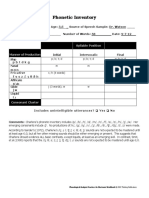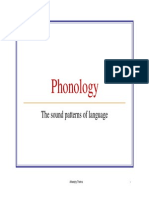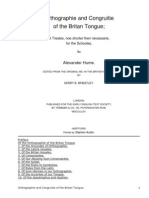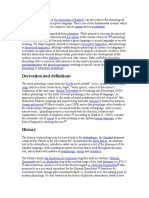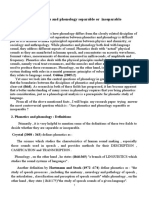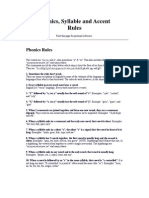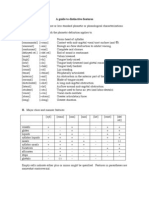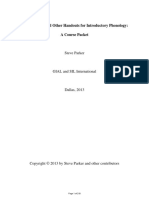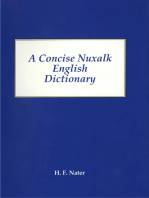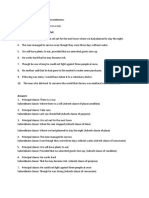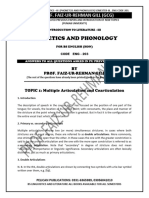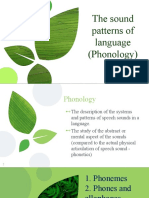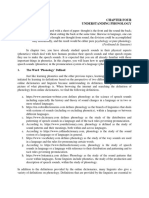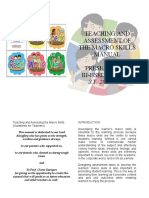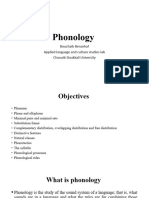3 Phonological Analysis Pp59 98
3 Phonological Analysis Pp59 98
Uploaded by
Nalin HettiarachchiCopyright:
Available Formats
3 Phonological Analysis Pp59 98
3 Phonological Analysis Pp59 98
Uploaded by
Nalin HettiarachchiCopyright
Available Formats
Share this document
Did you find this document useful?
Is this content inappropriate?
Copyright:
Available Formats
3 Phonological Analysis Pp59 98
3 Phonological Analysis Pp59 98
Uploaded by
Nalin HettiarachchiCopyright:
Available Formats
58 Distinctive Feature Theory 2.
5
of phonological features is identical to the inventory of phonetic features, .
and that languages implement these universal phonetic features in various
linguistic ways. In other words, phonetic features can be "phonologized"
by individual languages. Of course, it may be that a phonetic feature is used
phonologically by one language but not by another. In stating phonological
rules, features will be chosen which seem to best explain the motivation of the
processes in question.
PHONOLOGICftL fiNf1lYSIS
3.0 Different Views of the Phoneme
In Chapter 1 the difference between phonetics and phonology was
discussed. It was shown that in some cases phonological representations are
not identical to phonetic transcriptions. In addition, the notion of distinctive-
ness was discussed in Chapters 1 and 2. It was claimed, for instance, that two
languages can have exactly the same inventory of phonetic sounds (or
phones), but significantly different phonological systems. That is, the same
sounds can be organized in different ways. Just how much emphasis is to be
given to these "different ways" is a matter of much debate, as we shall see.
In this chapter we shall examine the nature of phonological analysis.
Since phonologists disagree in their basic assumptions about the nature of
phonology, we shall see that the specific analysis of the phonetic data of a
language greatly depends on the phonological theory underlying the analyst's
work, a fact which must be constantly kept in mind. All phonologists agree
that it is necessary to recognize both phonetic units (phones) and phonological
units (phonemes). But there are many differences beyond this basic agreement.
In 1.3 the phoneme was defined as a minimal unit of sound capable of dis-
tinguishing words of different meanings. Both /p/ and /b/ are phonemes in
60 Phonological Analysis 3.1
English, because they are capable of making a meaning difference, as in the
words pin and bin or cap and cab. The exact interpretation of the fact that
the word pin means something different from the word bin depends crucially
on one's conception of what a phoneme is.
In the following sections we shall present three views of the phoneme.
In 3.1 we shall see that some linguists in America in the 1940s
and 1950s) attempted to assign sounds to phonemes on the basis of their
distributional properties. In 3.2 we shall see that other linguists (particularly
those of the Prague School in Europe in the 1930s) assigned sounds to
phonemes on the basis of their functioning within a system of oppositions.
Finally, in 3.3 it will be seen that a third group of linguists view the phoneme
as a psychological sound unit. Each of these approaches has provided insights
into the nature of phonology, and the discussion will, hopefully, provide a
historical perspective.
3.1 The Phoneme as a Phonetic Reality
The first view asserts that the phoneme represents a physical phonetic
reality. That is, sounds which belong to the same phoneme share important
phonetic properties. Thus Daniel Jones (1931 :74) defines the phoneme as "a
family of sounds in a given language, consisting of an important sound of the
language together with other related sounds, which take its place in particular
sound-sequences." Similarly, Gleason (1955:261) defines the phoneme as
"a class of sounds which: (1) are phonetically similar and (2) show certain
characteristic patterns of distribution in the language or dialect under
consideration." Under this view the phoneme is seen as a convenient label
for a number of phonetic units. Thus fpf may stand for [p], [ph], [p:],
[p'], etc.
3.1.1 Minimal Pairs
The major task, then, for a phonologist holding this view of the
phoneme is to determine which sounds belong in the same class. In order to
do this, it is necessary to examine the distribution of the sounds in question.
If two sounds which are phonetically similar occur in the same phonetic
environment, and if the substitution of one sound for the other results in a
difference in meaning, then these sounds are assigned to different phonemes.
Thus, to continue the same example, if [ph] is substituted for the [b] in bin,
a different word results (namely pin). On the other hand, if [ph] is substituted
for the [p] in spin (see Chapter 1), we do not obtain a different word but
rather just a slightly distorted mispronunciation, which is likely to be inter-
3.1 Phonological Analysis 61
preted as [spin] in any case. We conclude that [ph] and [b] belong to different
phonemes, while [ph] and [p] belong to the same phoneme.
It can easily be demonstrated that two sounds belong to different phonemes
if we find two words which differ only in that one word has one of these two
sounds in a given position (for example, at the beginning of the word), while
the other word has the other sound in the same position. Two such words,
which differ only by one sound, are said to constitute a minimal pair. Thus
pin and bin are a minimal pair, since they differ only in their initial consonant,
just as cap and cab are a minimal pair, since they differ only in their final
consonant. On the other hand, pin and bit do not constitute a minimal pair,
since they differ in both their initial and final consonants. Finally, pin and
nip are not a minimal pair, since, although they involve the same three sounds,
there are actually two differences between these two words: initially, pin has
(ph] while nip has [ n ], and finally, pin has [ n] while nip has [ph] (pronounced
alternatively as an unreleased [p ]).
We thus conclude that whenever we can establish a minimal pair, the two
different sounds are phonetic manifestations of two different phonemes.
The above examples involving pin, bin, and spin are consistent with our
earlier definition of the phoneme as a minimal unit of sound capable of making
a meaning difference. The sounds [ph] and [p] do not make a meaning
difference in English, and so we assign them to the same phoneme, let us
say fpf. This phonological unit, on the other hand, contrasts with the [b] in
bin, and this latter sound must therefore be assigned to a different phoneme,
namely fbf. The following minimal pairs illustrate the pervasiveness of the
opposition between /p/ and /b/ in English:
INITIAL
pin
bin
MEDIAL
rapid
rabid
FINAL
rip
rib
It should be noted, relevant to the discussion in Chapter 2, that establishing
such minimal pairs reveals what the distinctive features of the language are.
Thus, we can see from the above examples that voicing is distinctive in
English. Such minimal pairs as tin : din and c[k ]ot :got reveal the distinctive-
ness of voicing in other consonantal oppositions.
3.1.2 Complementary Distribution
The existence of minimal pairs facilitates the work of the linguist
seeking to establish phonemic contrasts in this way. As Hockett (1955 :212)
puts it: "minimal pairs are the analyst's delight, and he seeks them whenever
there is any hope of finding them." This implies that it is not always possible
to find minimal pairs, and this may be due to a variety of factors. It may
simply be an accident that a language does not have in its vocabulary a
62 Phonological Analysis 3.1
minimal pair which distinguishes two sounds which theoretically could in
fact be found in exactly the same position. In such cases it is necessary to
rely on "near-minimal pairs." The German words Goethe and
Gotter 'gods' are a near-minimal pair for the vowel phonemes fe :f
and /ref. They differ not only in their first vowel, but also by the presence vs.
absence of a final /r/ phoneme. However, one can assume that the final /r/
of Gotter is not likely to have an influence on the first vowel-and can
therefore be disregarded in assigning [e:] and [re] to different phonemes.
1
There is, however, sometimes a structural reason why two sounds cannot
occur in the same environment. We have already seen, in Chapter 1, that the
sounds [ph] and [p] are generally not found in the same environment.
Since this is the case, it will be impossible in English to find a minimal pair
in which one word differs from the other only in that it has [ph] instead of
[p]. When two sounds are found in different environments, this is termed
complementary distribution; the two sounds are found in mutually exclusive
environments.
These environments may be stated in terms of syllable, morpheme, or word
structure or in terms of adjacent segments. An example involving both comes
from standard Spanish dialects. Although the words saber 'to know,' nada
'nothing,' and /ago 'lake' are written with b, d, g, they are pronounced re-
spectively [ sal3er ], [ naoa ], and [layo ], that is, with the voiced nonstrident
fricatives [13], [o], and [y]. On the other hand, these letters are pronounced
[b], [d], and [g] in the words banca 'bench,' demora 'delay', and gana
'desire.' If one were to look closely at the facts of Spanish, one would discover
that the sounds [13, o, y] are in complementary distribution with the sounds
[b, d, g]. While the details are somewhat more complicated (see Harris,
1969:38-40), in these examples voiced stops appear at the beginning of a
word, while voiced fricatives appear between vowels. That it is the inter-
vocalic environment that is conditioning the voiced fricatives is seen from
the following examples:
fa banca
la demora
Iagana
[Ia 13aiJka]
[Ia <Semora]
[Ia yana]
'the bench'
'the delay'
'the desire'
When one adds the feminine definite article !a, the voiced stops are then in
intervocalic position (that is, between vowels), and must therefore "spiran-
tize" to become [13, o, y]. Since these voiced fricatives (or spirants) are in
complementary distribution with the voiced stops, we have only one series
of phonemic consonants and not two. In a phonemic analysis based on the
1
While the vowel of rib is actually longer than that of rip (see 5.2.5), thereby disqualifying
[n:b] and [np] as a true minimal pair, it is often necessary to factor out such low-level
phonetic detail in phonemic analysis.
3.1 Phonological Analysis 63
distribution of sounds, [b] and [13] would be said to be allophones of the
same phoneme /b/, just as [d] and [o] are allophones of /d/, and [g] and
[y] allophones of fgf. An allophone is, then, a phonetic realization of a
phoneme in a particular environment. The voiced fricative [13] is the allophone
of the phoneme /b/ found between vowels, just as the voiced stop [b] is the
allophone of /b/ found at the beginning of a word.
In more recent approaches to phonology, such statements of allophonic
distributions have been superseded by the explicit formulation of phonological
rules. Thus, a rule such as the following,
would be postulated for Spanish, by which underlying (or pl;wnemic)
fb, d, g/ are converted to [13, o, y] between vowels. In terms of distinctive
features, this rule would be formulated as follows:
[
+voice!] -+ [ +cont] I [ +syll] _ [ +syll]
-nasa
An oral voiced consonant becomes continuous (that is, a fricative) between
vowels (see 4.3.1.2 for the abbreviatory conventions used in this rule).
Another case of complementary distribution comes from Standard German.
Note the distribution of the fricatives ['(] and [x] in the following German
words (see 1.4):
siech [zb;]
mich [mw]
Pech [PE9]
'sickly'
'me'
'pitch'
Bach
Buch [bu:x]
hoch [ho:x]
noch
[bax] 'brook'
'book'
'high'
'still'
The velar fricative [x] appears after the back (and rounded) vowels [u:, o:,
as well as after the central (unrounded) vowel [a]. The palatal fricative ['(]
is found after front (palatal) vowels, including front rounded vowels, for
example, Bucher [bii: '(;)r J 'books.' Since the central vowel [a J is specified
[+back] in distinctive feature theory (see 2.3.3.2), this complementary dis-
tribution is based on the distinction between preceding front and back
vowels. Notice that it also extends to the diphthongs written aifei, eufiiu,
and au-reich [rar'(] 'rich,' riiuchern 'to smoke (meat),' Rauch [raux]
'smoke.' Since plural formation in German often involves the fronting (or
umlauting) of a vowel, there will be numerous nouns with [x] in the singular
(after a back vowel) and [9] in the plural (after a front vowel). In addition to
the alternation between [ x] and [9] seen in Buch and Bucher above, other
examples are Dach [dax] 'roof,' pl. Dacher and Loch [bx] 'hole,'
64 Phonological Analysis 3.1
pl. LOcher [ l ~ r ] . The palatal fricative [c;] is therefore an allophone of the
phoneme fxf after front vowels, as stated in the following rule:
x --+- f; I [-back]-
v
Since only [c;] can occur after a consonant, for example, Storch [ st;,rc;]
'stork,' or at the beginning of a word, for example, Chemie [yemi:] 'chemistry,'
the exact distribution of [ x] and [c;] is somewhat more complicated than the
above rule would indicate.
3.1.3 Phonetic Similarity
While complementary distribution is generally a clue to the phono-
logical analysis of a language, there are cases where one might wish to
maintain phonemes in complementary distribution. That is, it may be
necessary to view some sounds in complementary distribution as belonging
to separate phonemes. One well-known case concerns the distribution of (h]
and [ lJ] in English. As seen in such words as head, heart, enhance, and perhaps,
[h] occurs only at the beginning of a syllable (enhance and perhaps are
syllabified as en-hance and per-haps). On the other hand, as seen in such
words as sing (silJ], singer [sil)-:}r], andjinger [fil)-gar], [IJ] always occurs at
the end of a syllable. Just as there are no English syllables ending in [h ],
there are no English syllables beginning with [ u]. It would thus appear that
[h] and [ lJ] are in complementary distribution and should therefore, as
suggested in 3.1.2, be assigned as allophones of the same phoneme.
While we shall ultimately argue that [ lJ] should be recognized as the
phonetic reflex of a phonemic /ng/ sequence (see 3.3.1), let us ignore this
analysis for the time being. A solution which would assign (h] and [ lJ] to
the same phoneme would appear unsatisfactory to most phonemicists, since
the two sounds appear to have very little in common. While [ph] and [p]
are both voiceless labial stops in English, just as [b] and [ ~ ] are both voiced
labial obstruents in Spanish, [h] and [ lJ] have little more in common than
that they are both consonants. [h] is voiceless, while [lJ] is voiced; (h] is a
fricative, while [lJ] is a (nasal) stop; [h] is oral, while [lJ] is nasal; [h] is
glottal, while [IJ] is velar, etc. In order to rule out a solution which would
assign these two sounds to the same phoneme, one must appeal to the notion
of phonetic similarity. As Hockett (1942:103) puts it, "if a and bare members
of one phoneme, they share one or more features."
The whole question of phonetic similarity is a complex one. In particular,
it is not quite clear whether this criterion for assigning sounds to the same
phoneme means that these sounds must share a phonetic property not shared
by other sounds or simply that they must share a phonetic property. A good
example comes from Gwari (Hyman, 1972a:l90). The phoneme /1/ is realized
as a voiced palatal stop fjf before fif, /ef, and fyf. Thus, /li/ 'to eat' is pro-
nounced [ji] and written orthographically as gyi. On the other hand, the
3.1 Phonological Analysis 65
phoneme /g/ is realized as [j] before /i/ and fe/. It seems clear that the palatal
stop (which is a realization of the phoneme /1/) is more phonetically similar
to [g] (as the main allophone of /g/) than is (j], and yet it is [j] and not [j]
which belongs to the fg/ phoneme. Thus, while allophones share constant
phonetic properties, there is no way of assigning sounds to phonemes on this
basis alone. Since we shall argue for the psychological reality of phonemes in
3.3, we can restate this problem in the following terms: while allophones of
the same phoneme share phonetic properties, it is not possible to determine
which sounds speakers of a language will judge as most similar by means of
examining the phonetic data alone. Instead, it is necessary to evaluate the
phonetic data on the basis of the entire phonological system, as will be seen
in 3.2.
3.1.4 Free Variation
Thus far we have discussed cases where two phones are assigned to
one phoneme. In all of these cases the two allophones have been seen to be
conditioned by context. For this reason they are sometimes referred to as
contextual variants or combinatory variants (Trubetzkoy, 1939:49). However,
it is possible that two phones may appear in the same context without causing
a change in meaning. In this case they are usually analyzed as free variants
or optional variants (Trubetzkoy, 1939:46). In English, final voiceless stops
occur both aspirated and unaspirated, for example, [ mreph] or [ mrep
0
]
'map,' [ mreth] or [ mret
0
] 'mat.' In these words two phones are found in the
same context, and no meaning difference results. We therefore cannot assign
[ph] and (p
0
] or [th] and (t
0
] to different phonemes. These differences
would appear to have no effect on the establishing of phonemic contrasts,
and the same speaker may sometimes use one phonetic realization of a
phoneme and sometimes the other.
Recently this notion of free variation has come under attack by socio-
linguists (for example, Labov, 1971 :432-437). Labov points out that free
variants often have sociological significance, and that these variants should
be accounted for quantitatively. That is, rules should be provided which
account for the relative frequency of."free variants.'' The same speaker may
use one variant in one sociological situation, while he may use the other in
another situation. A number of examples have been pointed out in the
literature. For example, it is well known that _some French speakers use an
alveolar trill [r] when they are home in a small town or village, but a uvular
fricative [a] when they visit Paris. This particular example illustrates that
some variants are due to sound changes which have not been uniformly
diffused throughout a community. One group, which enjoys greater prestige
throughout the community, may acquire one variant, while another group of
lesser status may acquire another variant. When a speaker of the second group
comes in contact with speakers of the first group, the result is "dialect
66 Phonological Analysis 3.1
mixture." In some cases, however, the two forms coexist in the same dialect
as the result of continued contact.
It is sometimes necessary to speak of free variation among phonemes.
Thus, the difference between /i/ and /r./ normally makes a meaning difference,
for example, beat and bet. However, the word economics can be pronounced
with either initial /i/ or /s/, without a consequent meaning change. Similarly,
although fu/ and juf contrast in words such as kook and cook, the words
roof and root can be pronounced with either of these vowels. It is therefore
possible not only to have noncontrasting allophones in the same context
but also to have noncontrasting phonemes in the same context in isolated
words.
3.1.5 Discovery Procedures
A number of American linguists of the 1940s and 1950s, who held
the view that the phoneme should be defined as a class of sounds, attempted
to provide a methodology or set of discovery procedures for establishing
phonemes. Harris (1951) devotes several chapters to the way phonemic
analysis should be done, but avoids a general theoretical statement as to
what the concept of the phoneme represents (for example, is it psychologically
real in the sense of 3.3). Pike (1947a:63) succinctly defines the phoneme as
follows: "a phoneme [his emphasis J is one of the significant units of sound
arrived at for a particular language by the analytical procedures developed
from the basic premises previously presented." Similarly, Hockett (1942:100)
defines the phoneme as "a class of phones determined by six criteria." These
criteria, which are treated in 3.4, include similarity, nonintersection (that is,
no phonemic overlapping), contrastive and complementary distribution,
completeness, pattern congruity, and economy. In the writings of such
linguists, as argued by Chomsky (1957, 1964), emphasis is placed on the way
a language should be analyzed, rather than on the way a language is. While
most theorists have been concerned with whether the phoneme represents a
phonetic reality, a phonological reality, or a psychological reality (as dis-
cussed in this chapter), it is possible to avoid the question of what the phoneme
is and ask only whether a given sound belongs to one or another phoneme.
Consistent with this approach is Twaddell's argument (1935) that the pho-
neme should be regarded as a convenient fictitious unit whose reality is yet
to be proven. Chao (1934:38) on the other hand, states: "given the sounds
of a language, there are usually more than one possible way of reducing them
to a system of phonemes, and ... these different systems or solutions are not
simply correct or incorrect, but may be regarded only as being good or bad
for various purposes." One such purpose, for instance, is clearly stated by
Jones (1931 : 78): "The main object of grouping the sounds of a language
together into phonemes is to establish a simple and adequate way of writing
the language." In stating the goal of phonemic analysis as such, Jones has
3.2 Phonological Analysis 61
. . .. d the discussion of what a phoneme is or represents to the question of
te4uce can best write a language phonemically. As we shall see in 3.2 and
boW one . .
th. er lingmsts have asked more of their phonemes.
3 .,, 0
3.2 The Phoneme as a Phonological Reality
The definition of the phoneme in purely phonological terms is
haracteristic of the Prague School. Trubetzkoy (1939: 36) defines the pho-
c me as "the sum of the phonologically relevant properties of a sound."
him, phonemes are defined in terms of oppositions in a.
system. The important notion in Pr.ague ?honology IS
"The phoneme can be defined satlsfactonly neither on the basis of Its
sychological nature [see 3.3] nor on the basis of its relation to the phonetic
p ariants but purely and solely on the basis of its function in the system of
(Trubetzkoy, 1939:41). Thus, a phoneme is a minimal unit that
can function to distinguish meanings. It is. not a sound or even a of
sounds, but rather an abstraction, a theoretical construct on the phonological
level. It is defined in terms of its contrasts within a system. For example, we
saw in Chapter 1 that the /b/ phoneme in English is very different from the
/b/ phoneme in Berber, since in the latter case there is no /p/ t? contrast with.
Approaching the phoneme as a class of sounds, one woul.d miss :he that
although [b J is assigned to fbi in both languages, there IS a basic difference
between this phoneme in English and in Berber.
3.2.1 Phonemic Overlapping
In several of the examples discussed, two phones were assigned to
the same phoneme, for example, [x] and [9] in German. One issue which
reveals a fundamental difference between defining the phoneme as a class of
sounds and defining it by its function within a phonological system of
oppositions is the question of whether one phone can be assigned sometimes
to one phoneme and at other times to another phoneme. Such a possibility,
termed phonemic overlapping, is raised by Bloch (1941) and is discussed by a
number of European phonologists (for example, Martinet, 1947; Fischer-
10rgensen, 1956:591). An example discussed by Jakobsen, Pant and Halle
(1952: 5) concerns Danish ftf and /d/. In syllable-initial position these pho
nemes are pronounced, respectively, [t] and [d], for example, [tag] 'roof'
and [ dag] 'day.' In syllable-final position, however, ftf is pronounced [d)
and /d/ is pronounced [5], as seen in the following words:
/hat/ -+ [had] 'hat'
/had/ -+ 'hate'
68 Phonological Analysis 3.2
We must recognize for Danish a rule which "weakens" consonants
syllable-final position. The result is that the [ d] of 'day' must be assigned
the phoneme /d/, but the [ d] of 'hat' must be assigned to the phoneme
Thus, one phone is assigned to one of two phonemes, depending on
context.
Such examples of overlapping pose a problem for adherents of the "'""""''"'
similarity criterion in phonemic analysis. What it means is that it is not
to predict what phoneme a given phone will be assigned to on the basis of
phonetic character alone, since we have seen [ d] to be assigned once to
and once to /d/. The idea that phones and phonemes could be identified
one-to-one basis, that is, that a given sound will always belong to a
phoneme and a given phoneme will always be associated with a given
is termed biuniqueness by Chomsky: "the biuniqueness condition ...
that each sequence of phones is represented by a unique sequence of
nemes, and that each sequence of phonemes represents a unique
of. phones" (1964: 94). If one were to adhere to phonetic similarity as
overriding principle in assigning phones to phonemes, one would be ---- ,., .
to say that syllable-final [ d] is a realization of the phoneme /d/, and
syllable-final [o] is the realization of a third phoneme joj, which is
only in this position.
Just as Chomsky showed that it is necessary in phonological analysis
allow for phonemic overlapping of the kind just illustrated (and merei,ore:-'l
argued against the biuniqueness condition), most European "'"'V"'""'"'"''o
noted the consistency of overlapping with their view of the phonemes in
system of oppositions. Thus, Jakobson, Fant and Halle (1952: 5) state:
patterns are identical if their relational structure can be put into a one-
correspondence, so that to each term of the one there carresponds a term
the other." In other words, [t] is to [d] in syllable-initial position as [d] is
to [o] in syllable-final position. In the terms of Martinet (1960:60), physical
identity does not necessarily imply linguistic identity.
Examples of phonemic overlapping are not particularly difficult to find.
One, from Danish again, is discussed by Martinet ( 194 7: 43). As seen in the
following diagram,
before fn/ before /rf
3.2 Phonological Analysis 69
th reare four contrastive vowel heights in Danish. The four front unrounded
- are normally realized (indicated in the diagram as before /n/) as
e, e, a]. However, before /r/ rule vowel lowering yielding
hOnetic series [ e, e, a, a]. Wh1le th1s. process modified the phon:tlc
pbaracteristics of each vowel phoneme, 1t can easily be seen that the relatiOn
the four vowels has remained constant. Thus, the vowel [e] of [er]
sequences is assigned to the /i/ phoneme, even the vowel_ [ e] [en]
equences is assigned to the jej phoneme. Damsh 1s analyzed m this way
the phoneme /i/ is defined not in phonetic terms but rather in terms
of its function within the total vowel system. In particular, rather than de-
fining ji/ as consisting of a particular class of sounds, we define /i/ as the
-highest front vowel in Danish. Similarly, we define /e/ as the second-highest
front vowel. Thus, when we have to assign the [ e] of [ er] sequences to a
vowel phoneme, we choose /i/, since [e] here represents the highest front
vowel before jrj. As in the case of Danish jtf and /d/, we can apply Jakobsen,
Fant and Halle's notion of relational structure: [i] is to [e] before jnj as [e]
is to [ e] before Jrf.
3.2.2 Neutralization
Bloch (1941 : 66-67) makes the distinction between partial overlapping
and complete overlapping: "The intersection or overlapping of phonemes will
be called partial if a given sound x occurring under one set. of phonetic
conditions is assigned to phoneme A, while the same x under a different set of
conditions is assigned to phoneme B; it will be called complete if successive
occurrences of x under the same conditions are assigned sometimes to A,
sometimes to B." The two examples discussed in the preceding section both
represent cases of partial overlapping.
A case of complete overlapping pointed out by Bloch involves English /t/
and fd/. Intervocalically, /t/ and Jd/ are both pronounced as an alveolar
tap [r]. Thus, for many speakers of American English, the words betting
and bedding are pronounced identically, that is, as [bwiJ]. One might,
however, attempt to assign different phonemic representations to the two
words on the basis of the fact that betting contains the word bet and bedding
contains the word bed. Assuming that the velar nasal should be phonemicized
as fng/ (see 3.3.1), the two phonemic representations would then be /betmg/
and fbedmg/. In this case, however, it would be necessary to state that both
Jt/ and /d/ have the allophone [r] in the same environment, namely in
intervocalic position. What this means in terms of Prague School phonology
(see 2.2.3) is that an opposition has been neutralized in this position.
While ft/ and /d/ contrast initially, as in the words tin and din, and while
they contrast finally, as in the word bet and bed, they do not contrast intervo-
calically (with the additional restriction that the preceding vowel is stressed).
70 Phonological Analysis 3.2
In 2.2.3, such an opposition was termed neutralizable. On the other hand,
contrast between fp/ and /b/ is, at least with respect to initial, medial,
final position, a constant opposition (see, however, footnote 3, Chapter
Trubetzkoy (1939: 78) differentiates positions of neutralization, where
neutralization takes place, and positions of relevance, where the opposition:
is realized phonetically. Thus, in the above example, the intervocalic position
is the position of neutralization, while the initial and final positions are the
positions of relevance.
Notice that if phonemic forms such as fbr.tmg/ are to be permitted for
English, then the phonological analysis will be possible only if the phonologist
goes beyond the phonetic data. In particular, it must be known whether there
is a word bet that exists independently, and whether this word exists as a
morpheme in a word such as betting. This consideration clearly goes beyond
the distributional analysis inherent in discovering complementary distribution,
In this case we not only need to know whether two forms are the same
(one phoneme) or different (two phonemes), but also we must establish
exactly which morpheme (for example, bet or bed)) is present. In otherwords,
we must introduce grammatical information into the phonological analysis.
In terms of the positions outlined in 3.3.2, this amounts to "mixing levels."
2
To combat the problem of neutralization, Prague School phonologists
introduced the archiphoneme. Consider a language such as Fe?fe?-Bamileke,
which has the following sequences:
ku ~ i ~ u
ke ko ~ co
Since both [k] and [c] are found before fe/, faf, fof, and fuf, we corlclude>
that they belong to separate phonemes, that is, /k/ and fcf. However, there
is a problem concerning the vowel /i/, since only [c] is found before it.
There are sequences of [ci] in this language, but *[ki] is not found. If
were to analyze [ci] as fci/ phonemically, Praguians would point out that
this fc/ is not the same as the fc/ found in other positions. The phoneme fc/
is defined in part by the fact that it stands in opposition to /k/. Before /i/,
however, this part of the definition is destroyed, since the difference between
[k] and [c] cannot be used here to make a meaning difference.
Instead of calling [c] before /i/ another instance of fcf, a separate phono-
logical unit is set up which is neither fc/ nor /k/, but which consists of all of
the phonological properties shared by fcf and /k/. This unit, termed an
archiphoneme, is by convention written as a capital letter, here /K/. /K/
stands for a voiceless noncontinuant, which would be specified in terms of
z In a phonemic analysis emphasizing the distributional properties of sounds, it would
probably be necessary to recognize a third phoneme /r/, because of its unique distribution
(it occurs only intervocalically and after certain sonorant consonants, e.g., party [parri]).
3.2 Phonologica!Analysis 71
distinctive features as [+high] (that is, either palatal or velar), but which
wo1lld not be specified with respect to backness. In other words, its speci-
fications would be as seen below, with [o back] indicating that this feature is
irrelevant (left blank), since it is neutralized:
[K/ : +cons
-syll
-son
+high
Oback
-ant
-cor
-voice
-cont
-nas
o strid
o del rei
In addition to [o back], the features Strident and Delayed Release are not
specified, since the archiphoneme does not specify whether the noncontinuant
is a stop or an affricate.
Since (c] before /i/ represents the neutralization of the opposition between
/k/ and Jc/, it would be incorrect in this framework to phonemicize [ci] as
fcif. Trubetzkoy (1939:78) draws support for this approach from linguistic
performance: "In neutralizable distinctive oppositions perception fluctuates:
in positions of relevance both opposition members are clearly distinguished;
in positions of neutralization, on the other hand, it is often not possible to
indicate which of the two had just been produced or perceived." Phonemes
which participate in neutralizations are thus felt by speakers to be closely
related. We might presume, as a result, that speakers of the above language
will regard fc/ and /k/ as more closely related than they will fc/ and ftf.
An example of neutralization often cited in the literature was discussed in
2.2.3. In Standard German, voiced obstruents are devoiced syllable-finally.
While the phonemes /t/ and jd/ contrast initially (for example, Tier [ti:r]
'animal' vs. dir [ di: r] 'to you') and intervocalically (for example, leiten
(lait:m] ' to lead' and leiden [laJd;)n] 'to suffer'), there is no possible contrast
syllable-finally. Thus, the words Rat 'advice' and Rad 'wheel,' which are
written differently, are both pronounced [ra:t]. Notice, however, that in
the plurals, where a suffix is added (which causes a vowel change as well),
the contrast been /t/ and fd/ resurfaces: Rate [rr.:t;)] 'advices' and Rader
[rr.:d;)r] 'wheels.' The question is how the final [t] of Rat and Rad should be
analyzed.
Phonologists maintaining a definition of the phoneme as a class of
phonetically similar sounds often disallowed complete overlapping (ne1l-
tralization) and were therefore forced to analyze both 'advice' and 'wheel' as
72. Phonological Analysis 3.3
fra:t/. Prague School phonologists, who saw the phoneme as a unit in
system of oppositions, could not analyze the final stop of these words as /t/,
since, unlike its counterpart in initial and intervocalic position, it cannot
stand opposed to fdf. Therefore, an archiphoneme would be set up. As stated
by Trubetzkoy, "In German the bilateral opposition d-t is neutralized in
final position. The opposition member which occurs in the position of
neutralization from a phonological point of view is neither a voiced stop nor
a voiceless stop but the 'non-nasal dental occlusive in general'." Thus the
underlying representation of both 'advice' and 'wheel' is fra:T/, where /T/
is specified [o voice], representing an archiphoneme sharing all of the
properties common to ftf and /d/. The words Rat and Rad thus end in a
dental stop which is redundantly voiceless.
3.3 The Phoneme as a Psychological Reality
The original mentalist position, as espoused by Badouin
Courtenay, defined the phoneme as "a mental reality, as the intention of the
speaker or the impression of the hearer, or both" (Twaddell, 1935: 56).
Since each time a speaker pronounces the sound [p] it is acoustically never
quite the same as the last [p ], the speaker must have internalized an image
or idealized picture of the sound, a target which he tries to approximate.
Badouin de Courtenay spoke of the phoneme as "a sound imagined or
intended, opposed to the emitted sound as a 'psychophonetic' phenomenon
to the 'physiophonetic' fact" (Jakobson and Halle, 1956:11). Thus, according
to the argument, in Nupe (where fsi/ is realized as [si]), when a speaker
pronounces [si] 'to buy,' his real intention or abstract image is fsif. Similarly,
when a speaker of American English says [ar mis;:J] 'I miss you,' his real
intention is [ai mrs yu], and so forth.
This view of the phoneme as a psychological unit was subject to attack by
phonologists holding the views of the phoneme discussed in 3.1 and 3.2.
The following statement of Twaddell (1935: 57) is perhaps representative of
American reaction against mentalistic definitions of the phoneme: "Such a
definition is invalid because (l) we have no right to guess about the linguistic
workings of an inaccessible 'mind,' and (2) we can secure no advantage
from such guesses. The linguistic processes of the 'mind' as such are quite
simply unobservable; and introspection is notoriously a fire in a wooden
stove."
Representative of the Praguian reaction to Courtenay, Trubetzkoy
(1939: 38) states: "Reference to psychology must be avoided in defining the
phoneme, since the latter is a linguistic and not a psychological concept."
3.3 Phonological Analysis 73
1'& Trubetzkoy, the phoneme is a characteristic of the linguistic system, and
.not of the minds of speakers:
The fact that the concept "phoneme" is here [in Courtenay's writings] linked
with such vague and nondescript notions as "psyche," "linguistic consciousness,"
or "sensory perception" cannot be of help in clarifying the phoneme concept.
If this definition were to be accepted, one would never know in an actual case
what to consider a phoneme. For it is impossible to penetrate the "psyche of all
members of a speech community" (especially where extinct languages are
involved). (1939 :39)
Although perhaps most phonologists reacted to the strong psychological
wording of Courtenay's pioneering work, this does not mean that they com-
pletely refrained from discussion of psychological (for example, perceptual)
aspects of the phoneme. Virtually all theorists agree that the phonemic
system of a language exerts a behavioral effect on its speakers. Few phonol-
ogists fail to make some remark about the role of the phonemic system in the
perception of foreign sounds. In the words of Trubetzkoy,
The phonological system of a language is like a sieve through which everything
that is said passes .... Each person acquires the system of his mother tongue.
But when he hears another language spoken he intuitively uses the familiar
"phonological sieve" of his mother tongue to analyze what has been said.
However, since this sieve is not suited for the foreign language, numerous
mistakes and misinterpretations are the result. The sounds of the foreign language
receive an incorrect phonological interpretation since they are strained through
the "phonological sieve" of one's own mother tongue. (1939:51-52)
Even Harris (1954: 36), who devoted so much attention to distributional
analysis, wrote: "Clearly, certain behaviors of the speakers indicate perception
along the lines of the distributional structure, for example, the fact that
while people imitate nonlinguistic or foreign-language sounds, they repeat
[his emphasis] utterances of their own language." While the antimentalist
phonologists of the 1930-1950 era were quick to reject all psychological
terminology, they did not refrain from pointing out that their nonpsycho-
logical phonemic systems have psychological validity fgr speakers.
The classic article on the psychological reality of phonemes is Sapir's
(1933) article bearing exactly this title. In this article Sapir reports the
following anecdote:
When working on the Southern Paiute language of southwestern Utah and
northwestern Arizona I spent a little time trying to teach my native interpreter ...
how to write his language phonetically .... I selected pa:fiah .... I instructed
Tony to divide the word into its syllables and to discover by careful hearing
what sounds entered into the composition of each of the syllables .... To my
astonishment Tony then syllabified pa:, pause, pah. I say "astonishment" because
I at once recognized the paradox that Tony was not "hearing" in terms of the
74 Phonological Analysis 3.3
actual sounds (the voiced bilabial p was objectively very different from
initial stop) but in terms of an etymological reconstruction: pa: 'water'
postposition *-pah 'at.' The slight pause which intervened after the stem
enough to divert Tony from the phonetically proper form of the postposition
a theoretically real but actually nonexistent form. (pp. 23-24)
What this means is that Tony had knowledge of the underlying /p/ in
postposition 'at,' which by rule becomes the voice spirant [f3]
In other words, the /p/ in the phonemic representation is psychologically
3.3.1 Levels of Adequacy
Examples such as the above reveal that phonology goes well
the systematizing of phones into phonemes. There has been much
of the goals of phonology. Chomsky (1964: 62ff), for example,
distmgms?es phonological analyses which are observationally adequate from
those which are descriptively adequate. A phonological analysis is observa-
tionally adequate if it accurately transcribes the data and nothing more. It is
descriptively adequate if, in addition to transcribing the data, it accounts for
the. knowledge (which Chomsky refers to as linguistic competence) of the
nattve speaker. Let us say, for instance, that one description of .wu
0
wu1
phonology states that there is a word play [pie J and a word clay [kle ], but no
word *tlay (presumably to be pronounced [tie]). Such a description reaches
the level of observational adequacy, since it correctly states that certain forms
are observed while other forms are not.
This cannot be said to reach the level of descriptive adequacy,
however, unless tt accounts for the fact that tlay not only is not observed but
could not be a possible word in the language. The native speaker intuitively
it is not possible to have a [tl] cluster at the beginning of a word
m Enghsh. Thus, a related fact is that English has the words pluck [plgk]
and cluck [klgk], but no word *tluck [tlgk]. A descriptively adequate
phonological description of English must include numerous constraints on
consonant sequences (see 1.4.1). Much more will be said about such con-
straints. For the moment it is important only to note that native speakers
have _knowledge of these constraints. Greenberg and Jenkins (1964) have
expenmentally demonstrated the native speaker's ability to judge non-
existent forms for their well-formedness, both in terms of sequences which
do or do not "sound English" and in terms of the distance of such forms
from good English-sounding words.
An example of a phonological analysis reaching the level of descriptive
concerns the velar nasal consonant [ IJ] in English. Many phonol-
ogtsts have observed that the velar nasal, which is written ng as in sing [ siiJ],
does not occur word-initially in English, although [ m J and [ n] do. A
phonological analysisof English could merely state this constraint, but there
3.3
Phonological Analysis 15
. . reason to believe that such an analysis too superficial. In
lS
9
cular, once this constraint is one further ask why .there
h a constraint to begin with. We mtght hypothestze that the sound IS too
lS, sue lt to pronounce in this position, but then there are many languages
do in fact allow [IJ] word-initially, as the spelling of the Vietnamese
-w:e Nguyen suggests. Thus, while [IJJ. is difficult a_n
n nounce at the beginning of a word, Its absence m this posttlon m English
:not be explained in universal tenus.
Rather, the reason we do not :find word-initial [ IJ] is that it derives
hi torically from an earlier *[IJgJ. Thus, the reason we find words such as
!at [mit] and neat [nit], but not *ngeat [ l)it], is a historical one. The velar
m al derives historically from [ IJg] at a stage where there was not only no
nasrd *ngeat [IJgit] but also no word *mbeat (mbit]or *ndeat [ndit]. That
word could not begin with a nasal consonant followed by a voiced stop.
is interesting is that although the [g] *[ IJg] has dropped, [ IJ]
continues to function as if there were a [g] after It.
In fact, Sapir (1925 :19) proposed that the sound [ IJ] be analyzed phono-
logicallY in English as /IJg/:
1n spite of what phoneticians tell us about this as d:n no
naive English-speaking person can be made to feel m his bones that tt. belongs
to a single series with m and n. Psychologically it cannot be grouped With them
because unlike them, it is not a freely movable consonant (there are no words
with 1J). It still feels like 1)g, however little it sounds like it. The relation
ant : and = sink : sing is psychologically as well as historically correct.
Chomsky and Halle (1968: 85n) propose that [ IJ] should be described phono-
logically as fngf Two rules are necessary:
l n -+ lJ I - {k, g}
2 g-+0/l)-#
Rule 1 assimilates fn! to [ IJ] before a velar consonant, for example, fsmk/
becomes [ sil)k]; Rule 2 deletes [g] after [ IJ] and before a word
(see 3.3.2 and 6.1.2.2 for discussion of boundaries). Thus, the full denvatton
of sing is as follows:
fsmg/ -+ siiJg -+ [sllJ] (by rules 1 and 2)
Given this fngf solution, a general sequential constraint can be formulated:
in English, no words begin with mb, nd, or ng, that is, no word begins with a
nasal consonant followed by another consonant. It is this constraint on the
phonological level which explains the failure of [ IJ] to occur at the beginning
of English words.
The fng/ solution reaches the level of descriptive adequacy because it
provides a principled reason for the exclusion of word-initial [ IJ]. In addition,
76 Phonological Analysis 3.3
Fromkin (1971: 34-35) presents evidence from speech errors for this
She reports that someone, instead of saying Chuck Young (the Chancellor
UCLA), said chunk yug. Phonetically, this represents a change from
intended [c::lk Y::liJ] to the speech error [c::liJk y::lg]. If it is assumed that
is phonologically fng/, then this error (as well as others) can be explained
saying that the nasal consonant was transferred to the first word, the:reh,,,.,
leaving a [g] sound stranded in the second word. The possibility of
data from speech errors to help choose among competing analyses seems
promising.
3.3.2 Grammatical Prerequisites to Phonology
One of the basic disagreements in the history of phonology has to do,
with what is referred to as "mixing levels." According to some
a phonological analysis would have to be justified on the basis of the phonetic
variants alone. In particular, information from a grammatical level (that is,
morphology, syntax) could not be used to justify an analysis. Hockett .
(1942:20-21) sums up this position: "There must be no circularity; phono-
logical analysis is assumed for grammatical analysis, and so must not assume
any part of the latter. The line of demarcation between the two must be
sharp." This position was sometimes maintained by phonologists focusing
on discovery procedures (see 3.1.5). Procedures were developed by
sounds could be assigned to phonological units (phonemes), which in turn
could, by other procedures, be assigned to grammatical units (morphemes,
words).
We have already mentioned Chomsky's criticism (1957: 50-53) of discovery
procedures. However, all one needs to disprove the claim that phonological
analysis can be done without recourse to grammatical information is to
find a language where the phonology cannot be described without reference
to the grammar, where "grammar" is used as a cover term for both mor-
phology (word structure) and syntax (sentence structure).
Such examples are not hard to find. Specifically, many phonological
descriptions require information such as (I) morphological boundaries and
(2) class categories, such as nouns and verbs. A good example of the latter
occurs in English. It is generally assumed that part of a complete phonology
of English will deal with stress phenomena. However, the placement of
stress in a word is partly dependent on whether that word is a noun or verb,
as seen in the following examples:
NOUN
pervert
subject
c6nduct
VERB
pervert
subject
conduct
3.3 Phonological Analysis 77
Whilethere are exceptions (for example, to ramble, a lament, a bab6on), some
of which can be explained in terms of syllable structure and vowel tenseness
(see and Halle, 1968), the above and verb forms suggest a
generahzatwn: stress falls on the first syllable m nouns, but on the second
syllable in verbs. Thus, for a particular set of noun-verb pairs, stress can
only be accounted for with reference to grammatical information.
Another example is found in Nupe (Hyman, 1970a). In Nupe, the phoneme
fS/ is pronounced [s] before /i/; for example, fsi/ 'to buy' is pronounced
(Si], but fsaf 'to cut' is pronounced [sa]. Thus, it would appear that the
difference between [ s] and [s] is completely redundant, since we can predict
which one is found on the basis of the following vowel. Phonemic fsf is
palatalized to [s] before the front vowel /i/ (as well as before fef and fe/).
There is, however, one exception. There is a process of reduplication in
Nupe which creates nouns from verbs, for example, [si] 'to buy' becomes
(sisi] 'buying.' The vowel in the reduplicated prefix is frequently [i] (but
see Hyman, 1970a:67-69 for a fuller statement; also 3.3.5). The exception
to the palatalization of /sf to [s] before /i/ arises when a verb such as /sa/
'to cut' is reduplicated as [ sisa] and not *[sisa]. If we were to base ourselves
entirely on the phonetics, we would be forced to say that the difference
between [s] and [s] is a distinctive one, sine(! the utterance [si sa] (from
fsi/ + jesa/ 'to buy a chair') is also found. Thus, [sisa] and [si sa] would
constitute a minimal pair. Such a minimal pair, which is possible only when
one of the forms is a noun derived through reduplication, should not be
allowed to destroy the complementary distribution of [ s] and [s] in the
language, which is otherwise completely general. With a minimum of gram-
matical information, we can still predict when we will find [s] and when we
will find [s]. Nupe speakers palatalize /s/ to [s] before /i/, except in such
cases of reduplication (see Wilbur, 1973, for theoretical discussion).
In addition to grammatical categories such as noun and verb, it is frequently
necessary to refer to grammatical boundaries in phonological analyses.
The boundaries which are used in phonology (see 6.1.2.2) include the full-
word boundary(##), the inter.nal word or stem boundary(#), and the general
morpheme boundary ( + ). An example of the relevance of such boundaries
comes from Fe?fe?-Bamileke. Consider the following data:
(a) po 'hand' mbo 'hands'
pe: 'accept' mbe: 'and accept'
pwa 'two' ntam pwa 'two hearts'
pi: 'profit' tum pi: 'send the profit'
(b) vap 'whip' vobi 'whip him/her'
!Jgop 'hen' !JgoM 'my hen'
pu: 'children' pe:pu: 'accept the children'
In several of these examples there is an alternation between [p] and [b ].
78 Phonological Analysis 3.3
Let us assign [p] and [b] as allophones of the phoneme /p/ (see Hyman
1972b, Chapter 3, for discussion of this solution). In (a), /p/ is realized as [b]
only in the first two examples in the right-hand column, as the result of a
rule which voices fp/ after [ m]:
p-+bfm_
However, in the third and fourth examples in the right-hand column, voicing
does not take place. The above rule is in effect blocked by the full-word.
boundary in the phrases 'two hearts' and 'send the profit.' Since there is
only an internal word boundary in 'hand' and 'and accept,' that is,
{m#pof 'hands'
/m#pe:/ 'and accept'
/ntam# # prna/
/tilm# #pi:/
the rule is not prevented from applying.
'two hearts'
'send the profit'
Similarly, the first two examples in the right-hand column of (b) show
/p/ becoming [b] intervocalically, as in the following rule:
p--+bjV_V
Since there is a full word boundary in fpe:##pii:/ 'accept the children,' no
voicing takes place. On the other hand, the internal word boundary of
/vop#i/ 'whip him/her' and /fJgO.p#a./ 'my hen' does not block the above
rule. Thus the distribution of [p] and [b] in Fe ?fe ?-Bamileke can only be
accounted for if it is possible to refer to word boundaries. Otherwise we
would be forced to conclude that the difference between [ mp] and [mb] is a
distinctive one, necessitating the positing of two phonemes /p/ and /b/.
Although grammatical boundaries play a role in phonology, some linguists
attempted to introduce "phonological" junctures in order to avoid mixing
levels. The junctures are responsible for phonetic differences in such phrases
as why try [ wa:I thrai] and white rye [wait raJ]. Thus, Z. Harris points
out (1951 :88): "Many of the junctures set up ... without reference to
morphologic boundaries turn out nevertheless to come precisely at mor-
phologic boundaries." While many of the phonologists eschewing the use of
grammatical information did not follow their own advice in practice, not all
of the linguists of the descriptivist era of the 1940s and 1950s in the United
States were even theoretically in agreement, as is evident from the following
statement made by Pike (1947b:158): "If language actually works as a unit,
with grammatical configurations affecting phonetic configurations, why
should we not describe the language and analyze it in that way? If forced to
do so, why pretend we are avoiding it?" The consequences, however, show
that one cannot proceed by operational steps from the physical sounds to
the phonemes and from the phonemes to the morphemes, etc. Since no
3.3 Phonological Analysis 79
alternative hypotheses or criteria were advanced, this particular theory
breaks down.
3.3.3 Morphophonemics
It is thus possible that the phonetic reflexes or realizations of
honemes not only reveal phonetically determined oppositions but also are
:etermined by grammatical facts. We have discussed two possible solutions
to the German case of final devoicing (3.2.2). The first solution, that charac-
teristic of American phonemics, is to identify the phonetic shape of the
segment found in the position of neutralization with the phonological
representation. Thus, Rat and Rad will both be represented as fra: tf. The
second solution, that characteristic of the Prague School, is to posit an
archiphoneme in the position of neutralization. Thus, German Rat and Rad
are both represented as fra:Tf. Both of these solutions fail to give an explicit
account of the fact that one instance of [ra:t] (let us say [ra:t]
1
) alternates
with a plural form with [t], that is, 'advices,' while the other instance
of [ra:t] (let us say [ra:t]
2
) alternates with a plural form with [d], that is,
'wheels.' The fact that there are basically two kinds of final ts
in German is overlooked.
Clearly, there is a certain relationship between [t] and [d] in German. Since
this relationship is missed by phonemic analysis, a separate, more abstract
level isrecognized, called the morphophonemic level, whose basic unit is the
morphophoneme. The basic motivating principle is that it should be possible
to give one representation to each morpheme (minimal meaningful unit of
grammar) and derive all of the allomorphs from this one "base form"
(barring, of course, the possibility that two allomorphs may not be phono-
logically related to one another, for example, go and went). The morpheme
'wheel' has two alternate phonemic forms or allomorphs in German: it has
the allomorph /ra: tf when the final consonant is followed by pause, but the
allomorph frs:d/ when the final consonant is followed by a vowel. This is
no accident. The same could be said about the noun Bund [bunt] 'union'
and its plural form Bunde ]. This morpheme has the allomorph
/bunt/ when the alveolar consonant is before pause, but the allomorph
fbund/ when there is a following vowel.
The base forms of these morphemes are {raT} and {bunT}, respectively.
These capital letters are employed to represent morphophonemes and should
not be confused with the archiphonemes discussed in 3.2.2. Here {T} is the
morphophoneme which is sometimes represented by the phoneme /t/ and
sometimes by the phoneme /d/. As Z. Harris states: "Each morphophonemic
symbol thus represents a class of phonemes and is defined by a list of member
pl\onemes each of which occurs in a particular environment" (1951 :225).
The example he discusses concerns the alternation between /f/ and fv/ in
80 Phonological Analysis 3.3
English, as exemplified in the forms knife/knives, wife/wives,
thief/thieves, etc. For such allomorphs Harris proposes the .... -...-, ..
{F}, for example, {naiF} 'knife,' which is sometimes realized as the uuurr:torn1
/naif/ (in the singular) and sometimes as the allomorph jnaiv/ (in the
Notice that while a word such as thief will have the base form {9iF} (since
plural thieves is formed with fv/), a word such as chief will have the
form {Cif} (identical with its phonemic representation jcif/), since its .... __ ,.,,.
is chiefs and not *chieves.
3.3.4 Systematic Phonemics
This notion of one base form per morpheme is carried over into
models of generative phonology presented as early as Halle (1959) and
characterizing most of the work being done in this theory.
3
.
The view is expressed in generative phonology that native speakers of
language tacitly know (that is, the knowledge is not necessarily cotlSCJtous}.'ci
that certain forms are related and that this relatedness must be ca];ltured.ii
somehow in the grammar. These phonologists propose that highly n<,tr<>l't,1j
systematic phonemic representations (equivalent in many respects to
phophonemic representations) be postulated, from which rules derive
various surface realizations. By postulating one underlying form at the
tematic phonemic level, from which surface alternants are derived, the
knowledge speakers have of general or systematic relationships
linguistically significant generalizations) in the phonological structure
accounted for. Chomsky and Halle (1968) point out that, as a result of
Great English Vowel Shift, there are vowel alternations such as those
in the following words (we shall limit this discussion to front vowels only): .
[iy] serene [&] serenity
obscene obscenity
[ey] profane [re] profanity
inane inanity
[ay] divine (I] divinity
sublime sublimity
On the basis of these alternations (and various other arguments), Chomsky
and Halle propose the following abstract systematic phonemic representa-
tions of these morphemes:
/seren/
/obsen/
/profren/
/inren/
/divin/
fsublim/
3
For a thorough statement of the "standard model" of generative phonology, i.e., of
systematic phonemics, see Chomsky and Halle (1968); for a more simplified and concise
introduction, see Schane (1973a).
3.3 Phonological Analysis 81
That is, tense vowels (indicated by V) are set up. Notice how closely
these underlying forms resemble English orthography. This comes as no
surprise, since these abstract forms coincide with historical reconstructions,
which are preserved in the orthography.
Three rules are required to produce the correct phonetic forms. First, there
is a vowel laxing rule, which for our purposes applies before the -ity suffix.
4
Thus, fseren/ becomes seren before the -ity suffix. Second, there is a vowel
shift rule which changes /i/ to IE, jef to i, and Jre/ to e. Finally, there is a
diphthongization rule by which IE becomes [ rey ], i becomes [iy ], and e
becomes [ey]. The derivations for (sgriyn] and [sgreruti] are given below:
fseren/
serin
seriyn
fseren + iti/
seren+iti Laxing before -ity
Vowel shift
Diphthongization
In Chomsky and Halle's framework, lax i and e are to be identified with
phonetic [1] and [e], respectively. The schwa found in the words serene and
serenity is due to a rule that reduces unstressed vowels to schwa.
The vowel shift rule is also used in conjunction with other alternations in
the language. Chomsky and Halle point out (p; 234) that alternations such
as resign : resignation and paradigm : paradigmatic, where the simple form
has [ ay] and the complex form [1g], must be accounted for, since these
forms are related. This relatedness is accounted for by providing a unique
base form for each morpheme. Looking at the word resign, Chomsky and
Halle argue for the systematic phonemic representation /re=sign/. A number
of observations are relevant here. The equal sign ( =) represents a special
morpheme boundary which is necessary in the following rule (p. 95):
s-+z/V=-V
The reason Chomsky and Halle wish to posit an fs/ in the underlying form
is that the same morpheme, they claim, occurs in words such as consign, where
the same = boundary is recognized. They argue that this boundary must
function in the rule voicing /sf to [ z ], since when there is no boundary, or
when there is a full + morpheme boundary (or perhaps a word boundary#),
fs/ remains [s] (for example, reciprocate, re-sign fre#sign/ 'to sign anew'V
4
This rule actually !axes the vowel of the third syllable from the end of the word. Thus,
the vowel of the syllable directly preceding -ity will automatically become lax.
5
are, however, important exceptions. While design is pronounced with [z], as
predicted by the above rule, desist is pronounced with [s] by some speakers. Since this word
IS represented underlyingly as /de-sist/, it should undergo the same intervocalic voicing of
/sf /re-sist/, which is pronounced [riZist]; cf. consist, which is pronounced with [s], since
fsl IS not in intervocalic position.
82 Phonological Analysis 3.3
Addressing ourselves now to the problem of the fgf in resignation and
absence in resign, Chomsky and Halle propose a g-deletion rule, the
of which is to tense the preceding vowel. (They discuss certain
in particular an intermediate [y] which tenses the preceding vowel and
drops.) Let us state the g-deletion as follows: /g/ falls when it occurs
a syllable-final /n/.
6
Thus, since the word-final /n/ of resign is also sylla
final, the fg/ falls. However, since resignation is syllabified as
the fgf remains. The derivation for [riyzayn] is as follows:
/re=sign/
re=zign
re=zin
ri=zren
[riyzreyn]
Underlying (systematic phonemic) form
Voicing of /s/
Drop of fg/ with concomitant tensing
Vowel shift
Diphthongization
(The resulting diphthong [my] is slightly modified to [ ay] ( = [at]) by
rule.)
3.3.5 Phonological Abstractness
It should be clear from the previous section that
"abstractness" is achieved by Chomsky and Halle and others in setting
underlying forms. The resulting systematic phonemic representations
considerably more distant from the surface phonetics than any other
of phonology ever would have tolerated.
Systematic phonemics, however, goes beyond proposing an
morphophonemic level, since, in developing this theory of vuuJlv""J,;,,t
Halle (1959) proclaimed the nonexistence of both the traditional phoneme '
and the phonemic level. That is, between the systematic phonemic
(resembling the old morphophonemic level) and the (systematic) phonetic .
level there would now be no linguistically significant level corresponding to '
the old phonemic level.
Chomsky (1964) and Postal (1968) devote much time to supporting
view. While phonology has experienced since The Sound Pattern of English
a shift back in the direction of a less abstract phonological level (see ...,.,.lfJ"'l""'J' ,,
1968a; Schane, 1971; Stampe, 1972a), it would be worthwhile to briefly.
examine the kind of argument given against what has come to be known
the "autonomous" or "taxonomic" phoneme (autonomous because some
phonemicists refused to admit grammatical information into their phono- .,
logical analysis, and taxonomic because sounds were merely classified,
ignoring important phonological generalizations expressible by rule).
6
Chomsky and Halle do not speak of syllables, but rather propose that /g/ falls before an
/n/ which is followed by either a full or internal word boundary (i.e., ## or #).
3.3 Phonological Analysis 83
Perhaps the best-known argument against a level intermediate between the
systematic phonetic and systematic phonemic is presented by Halle (1959:
22-23) and reproduced in Chomsky (1964:100-101). The claim is made that
recognizing a phonemic level will, in the words of Chomsky (1964:100),
"destroy ... the generality of rules, when the sound system has an assymetry."
The example comes from Russian, which has the following phonological
rule:
[-son]-+ [+voice] 1- ]
C +voice
.An obstruent becomes voiced before a voiced obstruent. Thus, a sequence
of ft/ followed by /b/ will be pronounced [db], but a sequence of ftf followed
by /1/ will be pronounced [tl], since [I] is a sonorant. The problem Halle
points out is that while there is a phonemic contrast between ft/ and fd/ in
Russian, there is no contrast between the phoneme fc/ (which exists in Russian)
and the phoneme /i/ (which does not exist). And despite the fact that there is
no voice contrast in the palatals, the same facts are observed with respect to
the voicing rule. That is, a sequence of /c/ followed by fbi will be pronounced
[Jb] (and, of course, /c/ followed by /1/ will remain [cl]). Since a strict
phonemic analysis adhering to phonetic similarity (biuniqueness) would be
forced to analyze [db] as /db/ (although the [ d] represents a neutralization
of ft/ and /d/ in Prague School terminology), the following rule is a morpho-
phonemic rule:
{t}-+ /d/ I- [
That is, it changes a morphophoneme into a phoneme. The following rule,
however, is a phonemic rule, since it merely states the allophonic distribution
of the phoneme fc/:
/'C/-+ [J] I- ]
+votce
Thus, although these two rules are clearly instances of the same rule (as
formalized in features above), they must be stated at different places in the
grammar. Assuming both a morphophonemic and a phonemic level, the first
rule converts a morphophonemic representation to a phonemic one and the
second converts a phonemic representation to a phonetic one. In order to
avoid this duplication (or lack of generality), it is necessary to reject the level
of autonomous phonemics and recognize only a systematic phonemic level
and a systematic phonetic level.
It would be unwise to suggest that all ofChomsky's (1964) criticisms apply
to all schools of phonemics. The above argument is of course limited, since
many phonemicists allowed neutralization of just the type found in Russian.
84 Phonological Analysis 3.3
Thus it would appear that it is not so much a question of establishing
difference between a systematic phonemic level and a phonemic level,
first of which is valid and the second invalid, but rather a question
defining what the characteristics of the one valid phonological level are.
While it is clear that the phonological level can differ considerably
the phonetic representation, generative phonologists themselves are
debating the question of just how "abstract" phonology is. Probably
generative phonologists would agree that the words 'advice' and 'wheel'
German, both pronounced [ra:t], should be represented phonologically
fra:t/ and /ra:d/, respectively (see Vennemann, 1968a). But
[riyzayn] as /re=sign/ is quite another story, for here we have to (1) rer>re1;en1t?!l
the high front diphthongized vowel [iy] as abstract fe/, (2) accept a
morphological boundary (=),and (3) represent [ay] as fig/, that is, a radically
different vowel with a consonant which is not realized phonetically (in
allomorph, at least).
There seem to be no constraints on the degree of abstractness allowable in
generative phonology. For example, Lightner (1971) considers the
of taking the underlying forms of English back to a Proto-Germanic stage
(before the application of Grimm's Law). He points out that there are
alternations such as the following between [f] and [p], [o] and [t], and
[h] and [k]:
foot pedestrian
father paternal
full plenary
mother maternal
father paternal
brother fraternal
heart cardiac
horn unicorn
hound canine
Perhaps the root of 'foot' should be recognized as the Latin-looking fped-/?
While almost no one would accept Lightner's proposal, his question is right
to the point: "Where does one stop? And why?"
One way of trying to limit the powers of generative phonology is by looking
at the nature of the rules that would be required. It is hard to imagine an
environment for changing underlying jped/ to [fut] other than by an arbitrary
diacritic, for example, [+X]. The rule could then be written as follows:
But since there is no phonological or morphological correlate to this diacritic,
this kind of rule would be equivalent to simply listing two forms in the lexicon,
/fvtj and jp;)dc:strilm/.
3.3 Phonological Analysis 85
l(iparsky (1968a) presented the first principled attempt to limit the powers
of generative phonology. He distinguished between contextual and absolute
neutralization. Contextual neutralization is the kind of situation we have
seen in English (intervocalic /t/ and /d/ are neutralized), Fe?fe? (/k/ and Jc/
are neutralized before /i/), and German (/t/ and /d/, among others, are
neutralized syllable-finally). Typically, when there is a rule of the form,
A B /- C (that is, AC -> BC)
there are already [BC] sequences coming from another source, we say
that fA/ and /B/ are neutralized before fCf. Absolute neutralization, on the
other hand, occurs when there is a rule of the form
and there are other instances of [B] coming from another source. The main
difference between the two types of neutralization, then, is that in absolute
neutralization the rule that accounts for the neutralization takes place
without any context. That is, all instances of underlying fA/ merge with
underlying /B/.
A concise example of absolute neutralization, which Kiparsky cites,
comes from Sanskrit, which has the following CV sequences:
ci 1ru
ea ka
Since there are no instances of *ki or *cu, /k/ and jcj are in near comple-
mentary distribution-they contrast only before fa/. However, it would be
possible to represent sequences of phonetic [ca] as underlying (systematic
phonemic) /kef, since there is no short [e] in Sanskrit, with the following
derivations:
Jki/ _. [ci]
/ke/ -> ee -> [ca]
The /k/ of /kef could be said to palatalize just like the Jk/ of /kif, yielding
intermediate ce. At this point a rule of the form
e->a
would convert all instances of Jef to [a], causing absolute neutralization
with fa/.
Kiparsky argues that rules of this form, which create context-free neu-
tralizations, should be disallowed, and he presents arguments from historical
linguistics to support his position. Notice, first, however, that it is not the
form of this rule of absolute neutralization that makes it so objectionable.
This rule can in fact be rewritten with a context, as follows:
e->a/c_
86 Phonological Analysis 3.3
In a sense this restatement is a trick, since it just so happens that aU
instances of underlying fe/ will occur after [c] at this stage in the derivation;
fe/ is posited only after /k/ (which will in turn palatalize to [c]). The real
objection seems to be simply calling something what it is not. That is, the
argument should be stated as one against "imaginary" segments (Crothers,
1971).
One such imaginary segment is the /re/ which Chomsky and Halle (1968)
posit as the phonological representation of the English diphthong [:li].
While a rule of the form
does not involve neutralization (since there is no other source of [:li]),
the postulated /ref of boy fbref is at least as "abstract" as the underlying /e/
considered for Sanskrit.
This reinterpretation of the problem is visible in the Yawelmani case
raised in the argument against Kiparsky by Kisseberth (1969). In Yawelmani,
the following surface phonetic vowels are found:
u
a o e: a: o:
Kisseberth argues that all instances of [e:] should be represented phono-
logically as fi:f, and some instances of [:l:] should be represented as /u:/,
others as /:l:{. This would produce the more symmetric inventory of both
long and short /i, a, u, :l/. His arguments are as follows.
First, there is a class of verbs of the underlying structure /CCV(C)/ which
Kuroda (1967) terms "echo verbs." A phonological rule inserts a vowel
between the first two consonants in the following way:
a CCe:(C)-+ CiCe:(C)
b CCa:(C) -+ CaCa:(C)
c CC:>:(C) -+ CuC:>:(C)
d CCo:(C) -+ C::!Co:(C)
Notice that cases b and d involve complete copying of the stem vowel,
though the copied vowel is always short. Having noticed this, if we were to
analyze verbs of class a as underlying /CCi:(C)/, then this ji:j would also be
copied as [i]. Similarly, if those verbs of the form [CuC:l:(C)] were recog-
nized as underlying /CCu:(C)/, then the copying rule would be completely
general:
e -+ V1 1 # c _ c Y ~ o
[-long]
A short version of the underlying vowel (Vi) of echo verbs is copied by this
rule.
3.3 Phonological Analysis 81
Another argument Kisseberth (1969) gives for his /i :/ and fu :f, solution
comes from vowel harmony. While the aorist (past indefinite) suffix is
represented phonologically as /hin/, it is converted to [hun] after some
instances of phonetic [ :l :] :
tuyo: hun 'urinated'
boyo:hin 'named'
As seen from the copied vowel [ u] in 'urinated,' this verb is represented
phonologically as jcyu :f. First the vowel/u :f is copied to yield intermediate
euyu:, and then the long vowel/u:/ is lowered to [:l:]. This solution ties in
neatly with the vowel harmony occurring in the aorist suffix. It is just those
verbs with underlying ju:f which harmonize /hin/ to [hun]. That this is
correct is seen from the fact that short fuj, but not short fo/, also harmonizes
Jbin/ to [hun]:
hudhun 'recognized'
gophin 'took care of an infant'
Thus, fhin/ becomes [hun J after the stem vowels fu :f and juf.
This solution requires a rule of the following form:
a [i:] -+ [e:]
b u: o:
Notice that only part b of this rule involves absolute neutralization, since
fu:f and f'J:f merge as ['J:] in all environments, while no merger occurs when
fi:/ is converted to [e:]. Although only the latter part of the rule involves
absolute neutralization, both involve setting up "imaginary" forms, that is,
phonological forms which do not exist on the surface and which are converted
to phonetic forms in a context-free fashion. The derivations for 'urinated'
and 'named' are therefore as follows:
/cyu: + hin/
cuyu:hin
cuyu:hun
[cuyo:hun]
/hyo: + hin/
hoyo:hin
[hoy:>: hin]
(by vowel copying)
(by vowel harmony)
(by vowel lowering)
So-called "imaginary" phonological representations characterize, at least to
some extent, probably all schools of phonology. Consider, for example, the
following phonetic vowel system of Nupe:
i
e
a
u
0
l ii
3
Although Nupe has five phonetic oral vowels, it has only three phonetic
nasalized vowels (Smith, 1967; Hyman, 1970b). The question, however, is
how the vowel [()] should be interpreted. Since there is an oral vowel fa/,
88 Phonological Analysis 3.3
pattern considerations suggest representing this vowel as fa/, the
reached by Smith (1967). Since /if and /fi/ tend to be pronounced [i]
[ u], a low-level phonetic rule is postulated which changes all nasalized vowels
to [-tense]. In a sense this amounts to recognizing an imaginary segment.
While in this case the distance between the phonological and phonetic
representations may seem negligible, no satisfactory way of measuring such
"distances" has been proposed.
In the absence of theoretical constraints on abstractness, such as the one
proposed by Kiparsky, a number of competing analyses will be possible of
the data of many languages, for example, a very abstract analysis, a not-too-
abstract analysis, a very nonabstract analysis. Since generative theory
attempts to provide the one descriptively adequate grammar of a language,
which is said to have psychological reality, proposals which limit the number
of possible analyses for any given data represent claims about the nature of
sound systems, which can in part be experimentally tested (see M. Ohala,
1974).
Since Kiparsky's unpublished paper, a number of papers, in addition to
Kisseberth (1969), have defended certain "abstract" analyses. A final example
of a possible abstract solution, again from Nupe, is presented in Hyman
(1970a), where it is suggested that [Cwa] and [CYa] should be represented,
phonologically, as jC'Jf and /Cs/, respectively. Since consonants are normally
labialized before fu/ and fof, and since they are normally palatalized before
/i/ and fef, we can simply extend the labialization and palatalization pro-
cesses to include /'J/ and /E/, as seen in the following rules:
c C" I _ m (LR)
U 1-m
After fC'Jf and /Cs/ have undergone the labialization rule (LR) and the
palatalization rule (PR), respectively, the following absolute neutralization
(AN) rule applies:
Since f'J/ and /EJ neutralize in a context-free fashion with fa/, this is a case of
absolute neutralization, as defined by Kiparsky (1968). We can, however,
provide a context for this rule, as follows:
3.3 Phonological Analysis 89
The rule now states that /'J/ becomes [a] after [Cw] and /E/ becomes [a]
after [CY]. This rule not only directly inc;orporates the motivation for the
rule (that is, the fact that the labiality and palatality of M and /Ef have been
transferred to the consonant), but also captures the fact that each instance of
[a] can be easily identified as deriving from j'Jf, /EI, or fa/ on the basis of the
preceding consonant, as seen in the following derivations:
/tO/_. tw6 __.. [twa] 'to trim'
MI._. tYs __.. [tYa] 'to be mild'
fta/ .... [ta] 'to tell'
Two kinds of evidence for this /'J/ and /E/ solution were proposed. First, it
was claimed that reduplication provides evidence for the underlying vowel
jof. As seen in the following examples,
ti 'to screech' .... titi 'screeching'
te 'to break' -. tite 'breaking'
ta 'to tell' -> tita 'telling'
tU. 'to ride' -> tutu 'riding'
to 'to loosen' -> tiito 'loosening'
the reduplicated vowel is [i] if the stem vowel is [-round], that is, /i/, /e/,
or fa/; or [u] if the stem vowel is [+round], that is, juj or joj. Notice,
however, the following forms:
twa 'to trim' .... tiitwa 'trimming'
tra 'to be mild' -. tWa 'being mild'
The expected form for 'trimming,' if /tw I is taken to be an underlying con-
sonant, is *twitwa. If, on the other hand, we recognize the underlying form
ft6j, this f'Jj naturally falls into the same class with fuj and /o/, and the
automatically chosen reduplicated vowel is [ u].
The second argument is based on the findings of Hyman (1970b) concerning
the nature of foreign sound assimilations in borrowing. It was argued in
Hyman (1970a) that since Yoruba [C'J] and [CE] come into Nupe as [Cwa]
and [cYa], the rule of absolute neutralization must be considered productive.
Some relevant examples are:
Yor.
Yor.
Yor.
Yor.
[kske] > Nupe
[sgbE] > Nupe
[t3re] > Nupe
[k6b5] > Nupe
{kYftkYa]
[egbYa]
[tWarYa]
[kwabwa]
'bicycle'
(a Yoruba town)
'to give a gift'
'penny'
According to this argument, the rule of absolute neutralization is responsible
for these borrowings, and for the fact that Nupes, when they speak Yoruba,
frequently replace Yoruba [C'J] and [CE] with Nupe [Cwa] and [CYa].
For justification of this kind of argumentation see Hyman (1970b) (and also
Ohso, 1971, and Lovins, 1973, for more recent work on this subject).
90 Phonological Analysis 3.4
The question of how Nupe should be analyzed has been raised a number of
times since the original abstract solution was proposed (see, for instance,
Harms, 1973, and, for a reply, Hyman, 1973d; also Crothers, 1971; Venue-
mann, 1973; Krohn, 1974). Just how abstract phonology is remains a
question that has yet to be answered in a manner satisfactory to all.
3.4 General Considerations in Setting Up Underlying
Forms
In preceding sections we saw basically three approaches to phono-
logical analysis, which can be summarized here by means of the following
example from English. As seen in the following forms,
im-possible
in-determinate
iiJ-congruous
the prefix meaning not' is pronounced [1m] before labials, [m] before
alveolars, and (at least optionally) [IIJ] before velars. The question is, how
should these forms be represented phonologically? In a strict phonemic
approach one might argue that the phonetic and phonological representations
are identical, that is, that these prefixes should be analyzed as the allomorphs
/Im/, /In/, and /ITJ/, respectively. Such phonologists would point out that since
the words ram [rrem], ran [rren], and rang [rrefJ] show a three-way nasal
contrast, the phonemes /m/, /n/, and /TJ/ are required in English. It should be
recalled that in this first view the phoneme was defined as a class of sounds
having phonetic similarity (see 3.1). Thus, by the principle of"biuniqueness"
(see 3.2.1), the sounds [m], [n], and [IJ] are assigned to the phonemes fm/,
/nf, and /TJ/ of the negative prefix, just as they are in the case of ram, ran,
and rang.
A second solution invokes the notion of neutralization from Prague
School phonology. Since nasals do not contrast before such consonants,
this morpheme can be represented as /IN-/, that is, with an archiphoneme
nasal which is specified as [+cons, +nasal], but which is left unspecified
for place of articulation. This solution then captures an important fact missed
by the strictly phonemic solution, since it recognizes fmj and Jnf only where
these two phonemes contrast, and recognizes JN/ where there is no contrast.
A weakness of both these solutions, however, is the fact that when this
prefix is followed by a vowel, its realization is [ n]. If one were to start with
underlying /m/, /n/, and /TJ/, then there would be no way to capture the fact
that the basic or unassimilated form of this prefix is [m], as in the word
inability. The same problem is inherent in the archiphoneme approach. On
3.4 Phonological Analysis 91
other hand, if one were to start with the representation /In/, a rule of
)lolllorganic nasal assimilation, written as follows,
n-+ [a place l!- [a place]
c
would state that /n/ assimilates to the place of articulation of the following
consonant. Thus, underlying /In/ is realized as [1m J before labial consonantfS
and as [IIJ] before velar consonants (in-congruous). Before
a).veolar consonants and before vowels (in-determinate and in-ability), it is
realized as [m].
Setting up one basic underlying form from which predictable allomorphs
or alternations can be derived runs into some difficulty, however, since, as
pointed out above, there seems to be no constraint as to how "abstract" the
base form can be. For example, while there is a productive rule of homorganic
nasal assimilation of the type seen above, we are faced with the problem of
what to do with words such as illegal and irregular, where the assimilation of
the fn/ of this same negative morpheme is complete. That is, /n/ assimilates
to [l] before [I] and [r] before [r], and presumably the resulting [11] and
[rr] sequences are later simplified to [1] and [r], respectively. Are the
underlying representations in-legal and in-regular too distant from the
phonetic representations? While phonologists disagree about the permitted
degree of abstractness, all those working in the framework of generative
phonology accept the notion of a base "underlying form" from which allo-
morphs are derived by phonological rules. With this in mind, we can now
ask, what are the general considerations in determining underlying forms?
3.4.1 Predictability
Given a phonological alternation, such as the alternation between
[t] and [d] in the German words Rad [ra:t] 'wheel' and Rader
'wheels,' how does one decide which of the two phonetic realizations is
dosest to the underlying representation? Or, in other words, how does one
determine the "basic allophone"? While there is no foolproof rule or
"discovery procedure," there are some general criteria which are sometimes
cited by phonologists. The first criterion is predictability. Often there is
little cause for hesitation, since the various alternations can be phonologically
predicted (that is, by rule) only if one starts with one of the allophones-but
could not be predicted if one started with the other. The German case of
final devoicing is an example. If the word 'wheel' is represented with a /d/
underlyingly, that is, fra:d/, then a rule of final devoicing would change /d/
to [t] in [ra:t], but not in the plural form The rule that converts
/b, d, g, v, z/ to [p, t, k, f, s] can be written as follows:
[-son]-+ [-voice] f _ $
92 Phonological Analysis 3.4
Voiced obstruents are devoiced in syllable-final position. If, on the
hand, 'wheel' were to be represented with underlying ftf, that is, fra:t/,
a rule would be required which would convert /p, t, k, f, sf to [b, d, g, v,
in some environment, so that /ra:t/ + (where - represents the
lauting process that fronts [a:] to [ E :]) is realized as :d;}r] and not
However, notice that the plural of Rat [ra:t] 'advice' is
Since both 'wheel' and 'advice' would presumably be recognized
fra:tf in this analysis, there would be no way of predicting which cases
finalft/ become [d] and which remain [t]. Since we can predict the a. ... ,,. .. -,.,
nations in one direction only, we assume that 'wheel' should be reJ>rei>ented ''!"
phonologically as fra :df and that there is a rule of final devoicing.
Of course, it would be possible to maintain both 'wheel' and 'advice'
fra: tf if we used some arbitrary diacritic mark, say [ + D ], to identify
morphemes whose final/t/ becomes [ d] by rule. By using such diacritics,
claim is made that this is not a purely phonological alternation, but rather
partly morphological one, since morphemes must be identified.
have generally argued that diacritics, while necessary to capture
in languages, represent complexities and should be used only when
phonological solutions (that is, ones using distinctive features only)
be motivated. Since the German rule can be written in strictly vuJu\.>1Vf>1"""1 xl
terms, the use of diacritics is ruled out.
A second example of the predictability criterion comes from
(Hale, 1971, as reported in Kiparsky, 1971). In Maori there is an
between certain consonants and 0 (that is, zero), as seen in the
examples:
VERB PASSIVE GERUND GLOSS
hopu hopukia hopukaiJa 'to catch'
aru arumia arumaiJa 'to follow'
tohu tohuiJia tohuiJaiJa 'to point out'
maatu maaturia maaturaiJa 'to know'
As seen in the leftmost column, the
vowel, in this case [u]. In the passive and gerund forms, however,
consonants appear on the surface, in this case [k, m, IJ, r]. There are
possible solutions. First, one might set up underlying forms which end
consonants. In this case we would recognize the underlying forms
/arum/, jtohuiJ/, and jmaatur/, and a rule which deletes word-final consonants;
C-+0/-##
The second solution recognizes the underlying forms fhopu/, faru/, /tohu/,
and /maatu/, and a rule of consonant insertion. However, in this case there ,
is a problem in predicting the exact identity of the consonant which
appear. There is no reason in this solution why fhopu/ should take a [k]
3.4 Phonological Analysis 93
but faru/ should take an [ m]. In other words, we are again forced into marking
such forms with diacritics, for example, [ + K], [ + M], etc. Since 0 can be
predicted .from final /k, m, IJ, r/, but. [k, m, IJ, r] be
phonologically predicted from 0, the first solutiOn IS preferred. Notice also
that there are some cases of verb forms ending in [u] which do not take any
consonant, for example, [patu] 'to strike,' passive [patua], gerund [patul)a].
(The expected passive [patuia] and gerund [patuaiJa] are simplified by rule.)
This verb will therefore be represented as fpatu/. (For more discussion of this
Maori data, see 5.2.8.)
3.4.2 Economy
In phonemic analysis, a solution is judged to be more economical
than another if it recognizes fewer phonemes. While this notion has not been
explicitly incorporated into generative phonology, it is sometimes invoked
in terms of overall "simplicity" (see 4.1) by generative phonologists.
One example is English ng. A solution recognizing a word such as sing as
fsif]/ is forced to admit an additional phoneme. A solution representing this
word as /sing/, since it avoids a phoneme/IJ/, is more economical. However,
economy in the number of phonemes or underlying segments frequently
entails a greater complexity in the phonological rules. As seen in 3.3.1, if
we recognize /sing/ we need to apply a rule of homorganic nasal assimilation
(which we already know characterizes English-compare /m-/), which yields
the intermediate form [ SI!Jg]. At this point we need to introduce a rule not
previously needed, namely, one which deletes the [g] of sing, thereby giving
the phonetic form [siiJ]. Notice that neither solution can be argued for by
the criterion of predictability. If we recognize an underlying /IJ/, then a [g]
will have to be inserted into the word longer (compare long [biJ]),
but not in the word singer [sll);}r]. If we recognize only fng/, then the fgf
will have to be deleted in singer, but not in longer. Thus, both solutions
require nonphonological information, namely boundary information. As
proposed by Chomsky and Halle (1968:85n), the underlying forms of longer
and singer are recognized with different internal grammatical boundaries,
/sing#;}rj and Post-nasalfg/ is deleted before a word boundary
(#), as in sing and singer, but not when there is only a morpheme boundary
( + ), as in longer, or no boundary, as in finger (see 6.1.2.2.).
3.4.3 Pattern Congruity
This criterion was cited by certain American phonemicists (for
example, Swadesh, 1934:36), who saw the phoneme as a (psychological)
point in a pattern (compare Sapir, 1925). In this view, a solution can be argued
for on the basis that it conforms to the overall pattern of the phonological
system. The fng/ solution is a good example. If a separate phoneme /TJ/ were
94 Phonological Analysis 3.4
recognized, we would have to ask why it, unlike /m/ and /n/, cannot
at the beginning of a word. If, on the other hand, fngf is posited, the
of [ IJ] to appear at the beginning of words in English can be explained
reference to a more general overall pattern; namely, just as fmb/ and
sequences do not occur initially, neither does fng/ (whose phonetic reflex
sometimes [ IJ]).
The use of pattern congruity as a criterion has led many phonologists
seek segments to fill "holes" in the pattern. For example, the
consonants represent the phonetic consonant system in Fe"te''--H;:tmilelce;il
(ignoring aspirated consonants):
p t k
?
b d
J
g
f 8
h
v z f y
m n
Jl lJ
1
w y
The columns represent places of articulation, the rows manners
(respectively, voiceless stops, voiced stops, voiceless fricatives,
fricatives, nasal consonants, liquids, and glides). A number of holes in
pattern are observed in the above chart. In addition, a number of coJilso,nants
stand by themselves (for example, [1]). Thus, typically, the
which are isolated are frequently moved into positions which are vacant in
more general pattern. For example, Fe?fe? has no voiceless velar
[x]. It does, however, have a glottal fricative [h], which we can
move into the velar slot to complete the series. Other rearrangements can
effected to yield the following phonetic chart:
p
b
f
v
m
w
t
d
s
z
n
1
l:
J
f
Jl
y
k
g
h
y
lJ
?
Other movements are the following: since the glides [ w] and (y] are made
a different point of articulation from [I], the two series are collapsed; since.
there is no back glide, the glottal stop has been moved into that position.
Notice that the bottom row contains segments which Chomsky and Halle
(1968) regard as [+son], though the case for treating a glottal stop as
sonorant is weak. While the consonant system has been made to look sym
metric, this has been at the expense of calling some phonetic segments
something they are not-for example,[?] is not a sonorant, [h] is not velar.
While by Sapir, who viewed phonemic structure as points in a pattern,
3.4 Phonological Analysis 95
arrays of sounds as seen above were accorded theoretical status, to other
phonologists such patterns merely summarize the phonetic segments of a
language. Thus, as reported in Hyman (1972b); the underlying (systematic)
phonemes of Fe?fe? are as follows:
t k '
b d j g
f s h
v
l11
(w)
z
n
(The fw/ is of questionable status.) Thus, phonemically, a number of holes
do exist in the pattern.
This manipulation is most frequently observed, perhaps, in the way
phonologists present vowel systems. In vowel systems with the three vowels
/i, u, a/, the five vowels /i, e, u, o, a/, or the seven vowels /i, e, e, u, o, :>,a/,
fa/ is often represented as a low central vowel, thereby giving the impression
of symmetry:
u i u i u
a e 0 e 0
a &
:)
a
In vowel systems with the four vowels fi, u, o, af, the chart is usually presented
as
i u
a o
rather than
a
u
0
even though fa/ is lower in vowel height than fof and is not necessarily a
front vowel. In this case, however, the symmetric vowel chart captures the
the fact that in such languages there is phonologically only a two-way vowel
height contrast and a two-way front/backness contrast. But to be consistent,
three-vowel systems should be written as in a or b:
a i u
a
b i u
a
Such diagrams represent the two possibilities for the phonological patterning
of /i/, /u/, fa/: in a fu/ and fa/ pattern together, as opposed to /i/, since
they are both [+back]; in b /i/ and fa/ pattern together, since they are
both [-round]. In the first language we should expect fu/ and fa/ to function
together in phonological rules, while in the second language we should
expect /i/ and fa/ to function together.
96 Phonological Analysis
3.4
One of the most frequent references to pattern congruity in
analysis concerns the question of whether something should be analyzed
one phoneme or two. For instance, in a language with an aspiration contrast,
such as Thai, one might ask whether the contrast should be represented
fp/ vs.fph/ or as fp/ vs.fph/. In the case of palatalization, one might
whether to set up a series of palatalized consonants (for example, jpY /) or
two-phoneme sequence of consonant followed by fyf (for example,
Such questions can frequently not be answered by the phonetics alone,
only by referring to the overall pattern of the language-in particular, the
general canonical shape of syllables. In Igbo, for instance, syllables generally
consist of a single consonant followed by a single vowel (that is, CV). The
major exception to this pattern is the presence of labialized velars,
could possibly be analyzed as fkw/, fgwj, and /uw/. However, if they were to
be analyzed as fkw/, fgwf, and /uw/, that is, as single consonants with a secon-
dary articulation, then they would not violate the syllable structure of the
language. If, on the other hand, we were to accept the two-phoneme analysis,
then the system would be broken, and we would have no explanation of why
fwf only occurs after /k/, fgf, and /rJ/. In the one-phoneme solution we
say that the language has labialized velars, and, since labialized velars
much more frequent and expected in languages than labialized labials or
labialized dentals, no further statement is required.
Another consideration in deciding whether to derive a given phone or
phones from one or two phonemes is whether the individual . ..
are found in isolation in the language. For instance, we could not analyze
aspirated stops as fph/, fth/, and fkh/ in a language where /h/ does not appear
alone. Similarly, the phonological representations fpy/ and fpw/ would be
avoided in languages that do not exhibit fyf and fwf functioning as in-.
dependent consonants. This consideration is an extension of what is known
in European phonology as the commutation test (Fischer-J0rgensen, 1956;
Martinet, 1960:73). From a minimal pair such as lamp and ramp in
we conclude that there is a distinctive contrast between the two phonemes
/1/ and frf. Now, from a minimal pair such as ramp and cramp, we conclude
that there is a distinctive contrast between 0 and /k/, and that cramp must
therefore be analyzed as having an initial consonant cluster, rather than a.
single initial consonant. Finally, the minimal pair ramp and amp shows that. .
ramp must be analyzed as having four phonological units, since /r/ contrasts
with 0 (compare camp and amp). Martinet (1960:74) applies this test to the
English ch sound. The question is whether this should be analyzed as /'C/
or ftsf, that is, as one phoneme or two. He points out that English has not
only the word chip [tsip], but also the word ship [sip]. From this opposition
of c:s (where c = ts phonetically), we conclude that the [t] of [tsip] con
trasts with 0. From the opposition between chip and tip [tip], we conclude
3.4 Phonological Analysis 97
tliat the [s] of [ tSip] contrasts with 0. Therefore, chip should be analyzed
by this criterion as /tsip/. On the other hand, since Spanish has this alveo-
palatal (fo: example, mucho 'very') but doesv not have the corre-
sponding fncattve [s], mucho must be analyzed as tmuco/.
While the commutation test yields these results, Martinet rightly rejects
the two phoneme /ts/ for English. He again appeals to the notion of pattern
congruity. He points out that this [ ts] sound must be analyzed exactly as the
corresponding voiced j (dz] in English. Now, while there is a word gyp
(dZip] and a word dip (dip], there is no word *[zrp] in the language. In
other words, [z] must always be preceded by [ d] when it occurs at the be-
ginning of a word. Since this is the case, [ dz] must be analyzed as one
phonological unit, that is, as fjf. And since Martinet wants to analyze the
ch sound in like fashion, he argues that the first argument from commutation
should be given up in favor of the pattern, and so we recognize underlying
fcf. (For more on the question of one vs. two phonemes, see 4.4.1.)
This, of course, points out the arbitrariness of this criterion, since it is
possible that each of two conflicting analyses breaks the pattern in a different
way. One wonders, for example, why fJI should not be reanalyzed as jdz/, on
analogy with ftsj, and not vice-versa. Notice, finally, that patterns change
through time. The Grebo language (Innes, 1966) generally exhibits a CVCV
pattern, but it has begun to syncopate vowels in fast speech (for example,
{fodo/ 'emptiness' becomes [flo] in rapid speech), such that there are now
syllables of the form CLV. With time we can expect the CLV forms to take
precedence over and eventually drive out the CVCV forms. In fact, there are
some forms, mostly borrowed, which only exist in their CLV form, for
example, [fli] 'flea.' Thus, whenever an argument is made for conforming to
a pattern, for example, CVCV, we have to be sure that the language is not on
the way to establishing another pattern. It may be that the old pattern is no
longer the criterion for congruity.
3.4.4 Plausibility
A fourth criterion that is often invoked is plausibility. Given two
possible solutions, is there one which in some sense is more plausible (or
"natural"-see Chapter 5)? Consider, for example, a language which has
the following phonetic sequences (Nupe comes close, although it also has
(sa]):
si su
se so
sa
The alveopalatal fricative [s] is found before [i] and [e] and the alveolar
98 Phonological Analysis 3.4
fricative [ s] before [ u ], [ o ], and [a]. Thus, we have a classic case of c o m ~
plementary distribution. There are two possible solutions. First, we can
recognize underlying /si, se, su, so, sa/ and posit a rule such as
which converts fsif and fse/ to [si] and [se ], respectively. Or we can recognize
underlying jsi, se, su, so, sa/ and posit a rule such as
which converts jsu/, jsoj, and /sa/ to [su], [so], and [sa], respectively.
The first solution is plausible, while the second solution is implausible.
Recognizing only fsf is plausible, because the rule which derives [s] before
/i/ and fe/ is a natural assimilation rule. That is, when /si/ becomes [si],
the alveolar /s/ assimilates to the frontness (or palatality) of /i/. Similarly,
when fsef becomes [se] the same assimilatory process is observed. On the
other hand, if we start with underlying /s/, the rule which is required to
derive [s] before fu/, fof, and fa/ is not a natural assimilation rule. While
the process of a palatal consonant becoming nonpalatal before a nonpalatal
vowel would appear to be assimilatory in nature, the question is why /8/
should become more fronted (that is, to [ s ]) rather than backed (to, say, [ x ])
before the back vowels in question. Thus, this rule seems to be unmotivated
from a phonetic point of view.
Rule plausibility usually refers to phonetic naturalness. Certain phonological.
rules are found to occur frequently in languages, and the reason for this
frequency is the fact that segments tend to assimilate to neighboring segments,
and they do so in fairly predictable ways (see Schachter, 1969; Schane, 1972).
The notion which is usually brought forth to explain these phenomena is
ease of articulation. It is claimed to be easier to pronounce [si] than [ si],
since in the first case both segments agree in palatality.
What this means is that plausible phonological rules are usually uni-
directional. Thus, one can use this criterion in phonological analysis and
try to establish an inventory of underlying segments from which the surface
segments can be derived by plausible rules. This criterion, like the other
criteria, is subject to other considerations. In particular, some languages do
have implausible or "crazy" rules (Bach and Harms, 1972). As discussed in
5.2.3, the most phonetically natural rule is not necessarily the most simple
rule. However, as a general principle, plausibility or rule naturalness is an
important criterion in conducting phonological analyses.
PHONOLOGICf1L
SIN\PLICITY
4.1 Simplicity, Economy, and Generality
In 3.4.2, the notion of economy was said to be one of the criteria
often used as a guide in phonemic analysis. A solution with fewer phonemes
is judged more economical than a solution recognizing more phonemes.
Similarly, we might say that a solution using fewer rules is more economical
than a solution requiring more rules, and so on. Economy, then, is a quanti-
tative measure by which a given solution can be evaluated as requiring fewer
or more mechanisms (phonemes, rules, conventions, etc.) than another
solution. This notion is characteristic of phonemic approaches to phonology,
and, as we shall see, has its application in the history of generative phonology
as well.
While one might be tempted to view a solution recognizing fewer pho-
nemes as "simpler" than a solution recognizing more phonemes, there is
another view which equates simplicity with generality. In terms of the
phonemic inventory, the following argument might be made:
sl Sz
i u u i u u
e 0 e 0 0
s :)
s re :)
a
a
You might also like
- Phonology ExercisesDocument7 pagesPhonology Exercisesomar chNo ratings yet
- Allomorphs of The Inflectional Morphems in PDEDocument1 pageAllomorphs of The Inflectional Morphems in PDEMonika SymanaiteNo ratings yet
- (Studies in Functional and Structural Linguistics, 66) Elena Even-Simkin, Yishai Tobin - The Regularity of The 'Irregular' Verbs and Nouns in English-John Benjamins Publishing Company (2013)Document292 pages(Studies in Functional and Structural Linguistics, 66) Elena Even-Simkin, Yishai Tobin - The Regularity of The 'Irregular' Verbs and Nouns in English-John Benjamins Publishing Company (2013)shyamNo ratings yet
- Morpho-Syntax (2017) ProgressTest4Document3 pagesMorpho-Syntax (2017) ProgressTest4Oanh Nguyễn0% (1)
- Palatalisation (Kochetov, Alexei)Document24 pagesPalatalisation (Kochetov, Alexei)reminder3No ratings yet
- A Phoneme As A Unit of PhonologyDocument10 pagesA Phoneme As A Unit of PhonologyqajjajNo ratings yet
- Principal AllophonesDocument23 pagesPrincipal AllophonesAnnNo ratings yet
- PhoneticsDocument14 pagesPhoneticsAshley JacksonNo ratings yet
- Inflection & Affixes Pres NewDocument27 pagesInflection & Affixes Pres Newtonny utomoNo ratings yet
- UPP - 2 - Practice Exercises (Phonological Variation and Underlying Representations)Document3 pagesUPP - 2 - Practice Exercises (Phonological Variation and Underlying Representations)essaywritingNo ratings yet
- Phonological Analysis ProjectDocument16 pagesPhonological Analysis ProjectUsamah HussainNo ratings yet
- Manner of ArticulationDocument8 pagesManner of ArticulationSyafiq ImanNo ratings yet
- 102 - Task 2-Consonant Sounds - Mayra Angelica Correa OrdoñezDocument6 pages102 - Task 2-Consonant Sounds - Mayra Angelica Correa OrdoñezAngelica CorreaNo ratings yet
- Intro To Phonological AnalysisDocument270 pagesIntro To Phonological AnalysisandrecasarNo ratings yet
- English Orthography WikipediaDocument21 pagesEnglish Orthography WikipediaThomas WalkerNo ratings yet
- Minimal Pairs Exercises IDocument2 pagesMinimal Pairs Exercises IMiguel Perez100% (2)
- Phonetics and Phonology Task 6Document10 pagesPhonetics and Phonology Task 6Lidia Calderon GaonaNo ratings yet
- Generative PhonologyDocument23 pagesGenerative PhonologyAbu UbaidahNo ratings yet
- Phonetics and Phonology: What Is A Phoneme?Document12 pagesPhonetics and Phonology: What Is A Phoneme?Frank Carrizo ZiritNo ratings yet
- Minimal Pairs Exercises IIDocument2 pagesMinimal Pairs Exercises IIMiguel PerezNo ratings yet
- Universitas Sumatera UtaraDocument13 pagesUniversitas Sumatera Utarahety hidayahNo ratings yet
- 02chapter 2 SoundDocument98 pages02chapter 2 SoundRoger langaNo ratings yet
- Phonetics: The Scientific Study of Speech SoundsDocument35 pagesPhonetics: The Scientific Study of Speech SoundsSam Ng100% (1)
- Connected Speech and CoarticulationDocument21 pagesConnected Speech and Coarticulationany1687No ratings yet
- Lec 3 PhonologyDocument44 pagesLec 3 PhonologyThekra AltweejryNo ratings yet
- Of The Orthographie and Congruitie of The Britan TongueA Treates, Noe Shorter Than Necessarie, For The Schooles by Hume, AlexanderDocument43 pagesOf The Orthographie and Congruitie of The Britan TongueA Treates, Noe Shorter Than Necessarie, For The Schooles by Hume, AlexanderGutenberg.orgNo ratings yet
- The Basic Tenets of Generative PhonologyDocument11 pagesThe Basic Tenets of Generative PhonologyAbdel MalekNo ratings yet
- Catching Language - The Standing Challenge of Grammar Writing (Ameka, DenchDocument672 pagesCatching Language - The Standing Challenge of Grammar Writing (Ameka, DenchFrofScNo ratings yet
- Derivation and Definitions: The Phonology of EnglishDocument5 pagesDerivation and Definitions: The Phonology of Englishintan melatiNo ratings yet
- Seprable or InseprableDocument11 pagesSeprable or InseprablesaifNo ratings yet
- Phonics, Syllable and Accent RulesDocument3 pagesPhonics, Syllable and Accent RulesRosa CaudilloNo ratings yet
- Some Notes On English MorphologyDocument12 pagesSome Notes On English MorphologyJuliana LunaNo ratings yet
- Test N°1Document2 pagesTest N°1Miguel Perez100% (1)
- Distinctive Feature GuideDocument5 pagesDistinctive Feature GuideRachid GharibNo ratings yet
- 575964993 Đề Cương Ngữ Am Am Vị HọcDocument32 pages575964993 Đề Cương Ngữ Am Am Vị HọcTrang Võ Kiều100% (1)
- PHONETICS AND PHONOLOGY IV - Main ConceptsDocument36 pagesPHONETICS AND PHONOLOGY IV - Main ConceptsVickyBibiloniNo ratings yet
- Classification of ConsonantsDocument3 pagesClassification of ConsonantsGeorgiana Argentina Dinu100% (1)
- Phonetic and PhonologyDocument57 pagesPhonetic and PhonologyjimmyNo ratings yet
- Week 2 Morphology and SyntaxDocument7 pagesWeek 2 Morphology and SyntaxAnnisa RahmadhaniNo ratings yet
- Lecture - 17 - English - Lexicography (1) 6.11.23Document35 pagesLecture - 17 - English - Lexicography (1) 6.11.23Kamilla MakhambetovaNo ratings yet
- Above The Symbol For The Sound To Be NasalizedDocument4 pagesAbove The Symbol For The Sound To Be Nasalizedanmar ahmedNo ratings yet
- Practical Phonetics 2Document79 pagesPractical Phonetics 2harryo10100% (2)
- ÔN TẬP PHONETICSDocument53 pagesÔN TẬP PHONETICSChau Nhat ThanhNo ratings yet
- Ejercicios de FoneticaDocument4 pagesEjercicios de FoneticaAlberto CraviotoNo ratings yet
- The Sound Grammar PDFDocument3 pagesThe Sound Grammar PDFCharlie Abdullah Haddad100% (1)
- Mela Restania (372015002) Phonetics and PhonologyDocument17 pagesMela Restania (372015002) Phonetics and PhonologymellaNo ratings yet
- Lexicology EXAMDocument4 pagesLexicology EXAMAliyaNo ratings yet
- Creating A Vowel Chart in ExcelDocument3 pagesCreating A Vowel Chart in ExcelFrancisco BetancourtNo ratings yet
- PhonicsDocument15 pagesPhonicsmiha262003No ratings yet
- Phoneme & AllophoneDocument23 pagesPhoneme & Allophoneketoras314No ratings yet
- Origin of Tones in VietnameseDocument26 pagesOrigin of Tones in VietnameseFangzhi Jia100% (1)
- Manner of ArticulationDocument6 pagesManner of ArticulationDian Hadi NurrohimNo ratings yet
- Kisii UniversityDocument5 pagesKisii UniversityRobert LangatNo ratings yet
- Phonology Part 2Document23 pagesPhonology Part 2mustafa khalidNo ratings yet
- 2011 Generative PhonologyDocument147 pages2011 Generative PhonologyyavuzNo ratings yet
- Module Applied LinguisitcsDocument93 pagesModule Applied LinguisitcsJohn WilkinsNo ratings yet
- Ibn Tofail University LevelDocument23 pagesIbn Tofail University LevelImad Es SaouabiNo ratings yet
- Parker - Handouts Intro Phonology PDFDocument210 pagesParker - Handouts Intro Phonology PDFRyan Jefrey GallanoNo ratings yet
- Phonemes and Allophones - Minimal PairsDocument5 pagesPhonemes and Allophones - Minimal PairsVictor Rafael Mejía Zepeda EDUCNo ratings yet
- TM 1-3 FoneDocument22 pagesTM 1-3 FoneNatalia Suárez ÁmezNo ratings yet
- Formal Rejection Letter TemplateDocument2 pagesFormal Rejection Letter TemplateNalin HettiarachchiNo ratings yet
- Translation Competence An ArticleDocument23 pagesTranslation Competence An ArticleNalin HettiarachchiNo ratings yet
- Islcollective Worksheets Beginner Prea1 Elementary A1 Kindergarten Elementary School Reading Speaking Spelling Writing H 2120501940a27b96c8 74365001Document2 pagesIslcollective Worksheets Beginner Prea1 Elementary A1 Kindergarten Elementary School Reading Speaking Spelling Writing H 2120501940a27b96c8 74365001Apoyo EscolarNo ratings yet
- Open Competitive Examination For Recruitment To Class I of The Government Translator ServiceDocument7 pagesOpen Competitive Examination For Recruitment To Class I of The Government Translator ServiceNalin HettiarachchiNo ratings yet
- Be Verbs Fill in The Blanks With Present "Be " VerbsDocument3 pagesBe Verbs Fill in The Blanks With Present "Be " VerbsNalin Hettiarachchi33% (3)
- Reading Reading Comprehension Exercises - 67180Document1 pageReading Reading Comprehension Exercises - 67180Nalin HettiarachchiNo ratings yet
- Sesion Plan-Sinhala & Tamil NWDocument6 pagesSesion Plan-Sinhala & Tamil NWNalin HettiarachchiNo ratings yet
- Analyze The Following Complex SentencesDocument6 pagesAnalyze The Following Complex SentencesNalin HettiarachchiNo ratings yet
- Exercises 1 Handout PDFDocument7 pagesExercises 1 Handout PDFNalin Hettiarachchi100% (1)
- A Study Report Translation and Interpretation Training and Services in Sri LankaDocument25 pagesA Study Report Translation and Interpretation Training and Services in Sri LankaNalin HettiarachchiNo ratings yet
- Procurement NoticeDocument3 pagesProcurement NoticeNalin HettiarachchiNo ratings yet
- Gatsby 1Document3 pagesGatsby 1Nalin HettiarachchiNo ratings yet
- #Translation DayDocument5 pages#Translation DayNalin HettiarachchiNo ratings yet
- Sri Lanka English Literature-Hyderabad.dDocument12 pagesSri Lanka English Literature-Hyderabad.dNalin HettiarachchiNo ratings yet
- The Efficiency Medal: Reprint As at 15 January 1954Document12 pagesThe Efficiency Medal: Reprint As at 15 January 1954Nalin HettiarachchiNo ratings yet
- B.A. (Gen. English)Document156 pagesB.A. (Gen. English)sandiNo ratings yet
- Materi Penyegaran PhonologyDocument31 pagesMateri Penyegaran PhonologyAbdul Rahman Al RisqiNo ratings yet
- BS ENGLISH (PU) PAST PAPERS SOLVED. (Phonetic and Phonology) Added Topics in BOOK Linguistics-III, Sem-III BY PROF FAIZ-UR-REHMAN GILLDocument38 pagesBS ENGLISH (PU) PAST PAPERS SOLVED. (Phonetic and Phonology) Added Topics in BOOK Linguistics-III, Sem-III BY PROF FAIZ-UR-REHMAN GILLAqsa sajidNo ratings yet
- Task 4Document5 pagesTask 4Noel TorradoNo ratings yet
- Overview: Module 6Document23 pagesOverview: Module 6Islam TahaNo ratings yet
- Assignment 1 - FOLDocument7 pagesAssignment 1 - FOLVan LeNo ratings yet
- Chapter 4 - PhonologyDocument30 pagesChapter 4 - PhonologyBao Ngoc NguyenNo ratings yet
- The Word Phonology' Defined: Chapter Four Understanding PhonologyDocument13 pagesThe Word Phonology' Defined: Chapter Four Understanding PhonologyJoyNo ratings yet
- Pronunciation in Use Intermediate 2012 Student SampleDocument9 pagesPronunciation in Use Intermediate 2012 Student SampleEarl Mark Rafael100% (2)
- Applied Linguistics Handout LessonDocument23 pagesApplied Linguistics Handout LessonArgene MonrealNo ratings yet
- Elt 315 Final Proj.-Iii-Bsed English ManualDocument20 pagesElt 315 Final Proj.-Iii-Bsed English ManualRosé SanguilaNo ratings yet
- Spoken EnglishDocument32 pagesSpoken EnglishelidrissibutterflyNo ratings yet
- 1-20 Handout - LINGDocument2 pages1-20 Handout - LINGDanielle LoboNo ratings yet
- Applied Phonetics and Phonology TSL 485 Week 6 Phonology: Fakulti Pendidikan Uitm, Shah AlamDocument35 pagesApplied Phonetics and Phonology TSL 485 Week 6 Phonology: Fakulti Pendidikan Uitm, Shah AlamLyana RoslyNo ratings yet
- Cog1 SG 7Document5 pagesCog1 SG 7Darlene Joy CambayNo ratings yet
- Step 4 - Speech Sounds and SemanticsDocument8 pagesStep 4 - Speech Sounds and SemanticsJuliana Yarledy CuellarNo ratings yet
- Assessing Listening (Onsite & Online)Document30 pagesAssessing Listening (Onsite & Online)Khofifah HrpNo ratings yet
- Classical PhonemicsDocument8 pagesClassical Phonemicsgoodluck laba100% (1)
- Parker - Handouts Intro Phonology PDFDocument210 pagesParker - Handouts Intro Phonology PDFRyan Jefrey GallanoNo ratings yet
- Distinction Between Langue ( Language System) and Parole ( Speech)Document9 pagesDistinction Between Langue ( Language System) and Parole ( Speech)Aleksandra StasiakNo ratings yet
- Jurnal Internasional Ibu HarsiaDocument8 pagesJurnal Internasional Ibu HarsiaAllda LasarNo ratings yet
- Action Research Chapter 3Document3 pagesAction Research Chapter 3Jessalyn Nuñez BrionesNo ratings yet
- Sample End Test On Phonetics 1Document6 pagesSample End Test On Phonetics 1Vy PhươngNo ratings yet
- Advanced Study in English LanguageDocument18 pagesAdvanced Study in English Languagehames20547No ratings yet
- BAJOLIN (2020) Language Documentation-A Phonemic Analysis of FakkanciDocument20 pagesBAJOLIN (2020) Language Documentation-A Phonemic Analysis of FakkanciOldmanNo ratings yet
- Cambridge Delta LSA 2 (Skills) : Teaching Listening: March 2021Document16 pagesCambridge Delta LSA 2 (Skills) : Teaching Listening: March 2021DeborahCordeiroNo ratings yet
- 2.Phonetics_phonology (1)Document20 pages2.Phonetics_phonology (1)PolZefirkiNo ratings yet
- PhonologyDocument58 pagesPhonologyAbdellah ElhamzaouiNo ratings yet
- Sound Spelling CorrespondencesDocument2 pagesSound Spelling Correspondenceslolags1407No ratings yet










